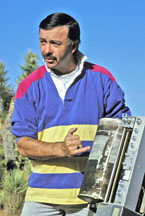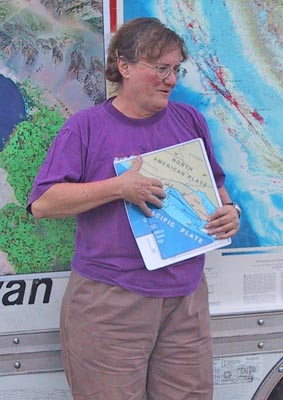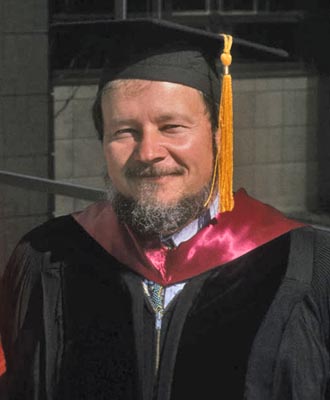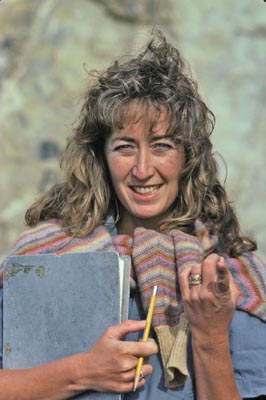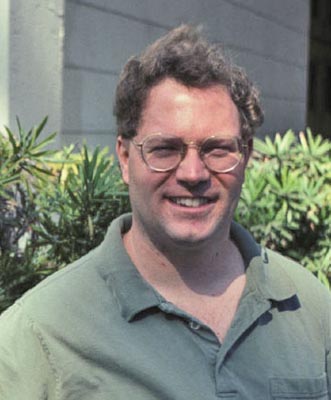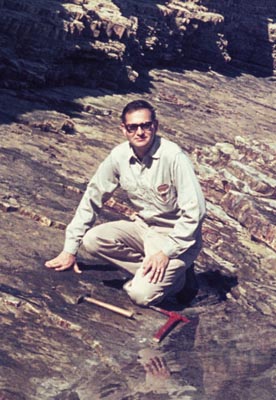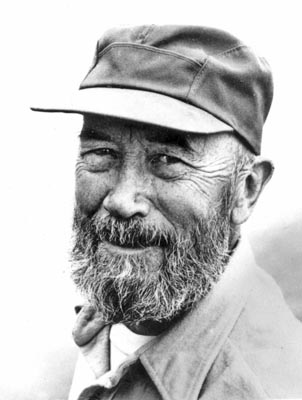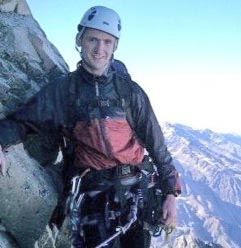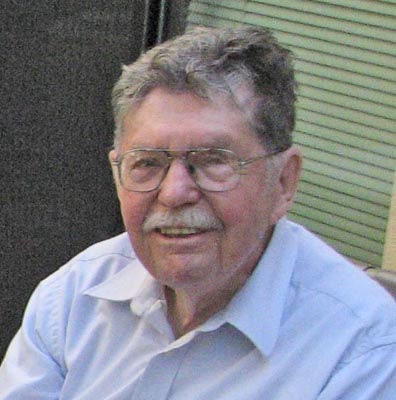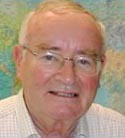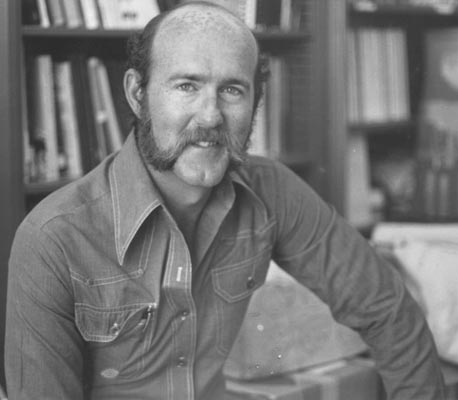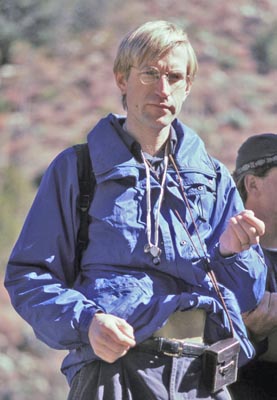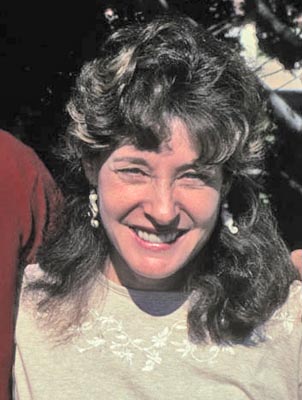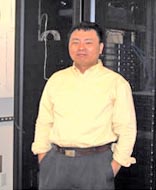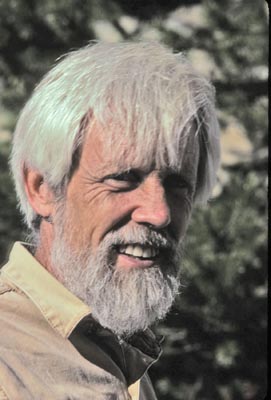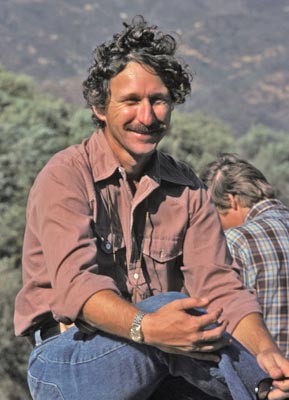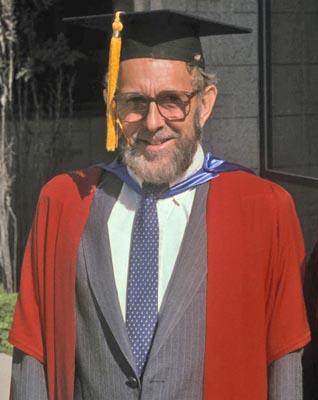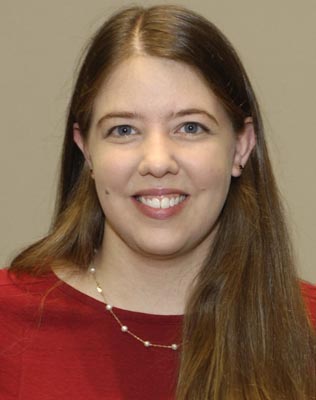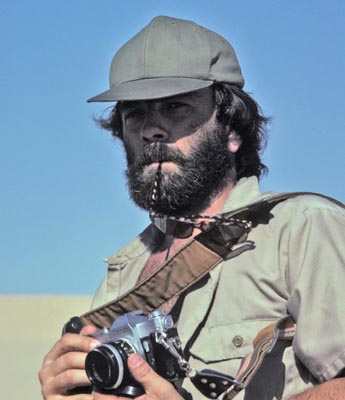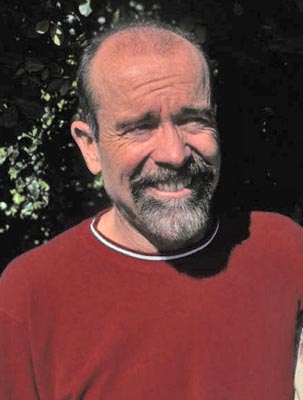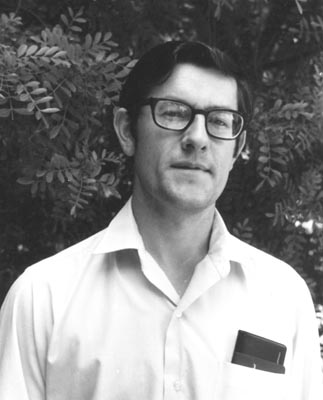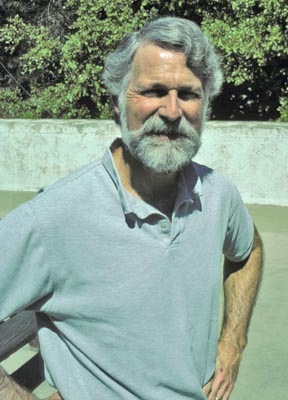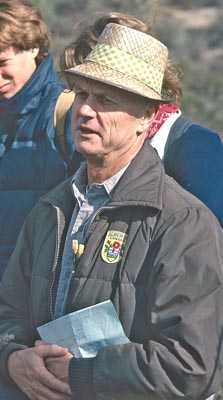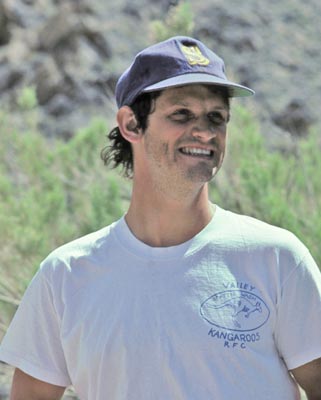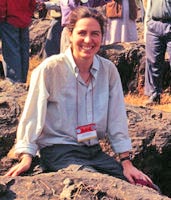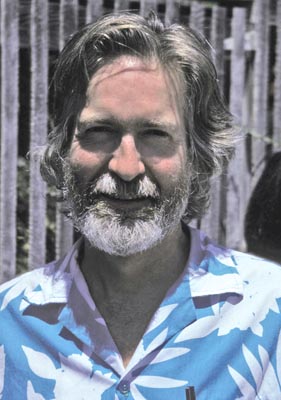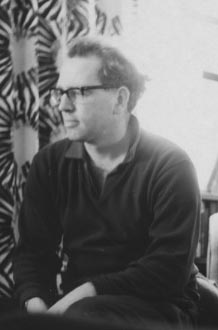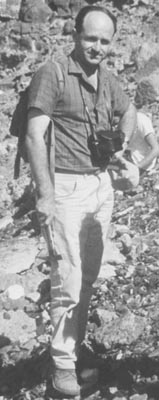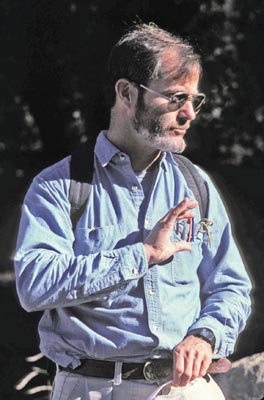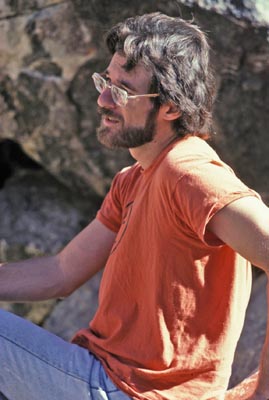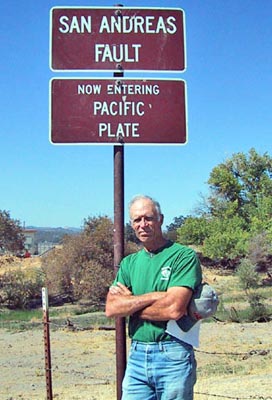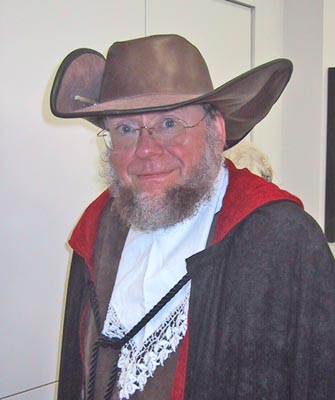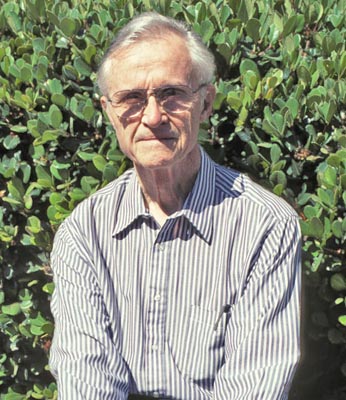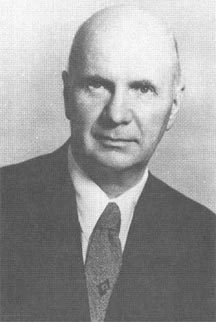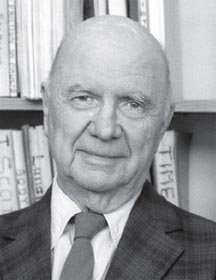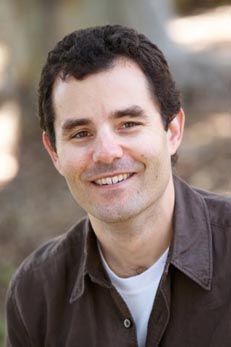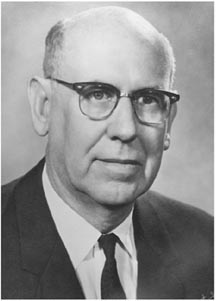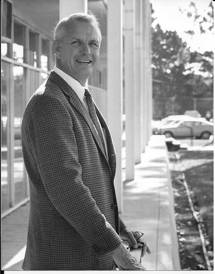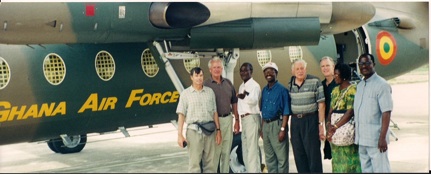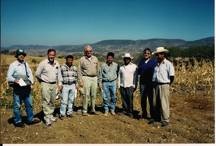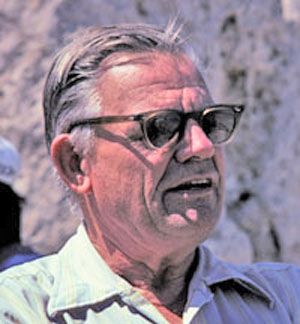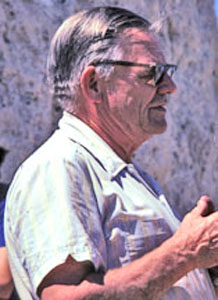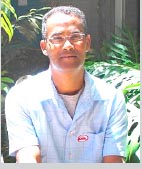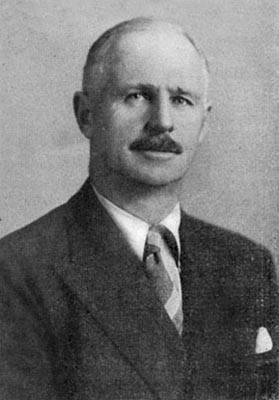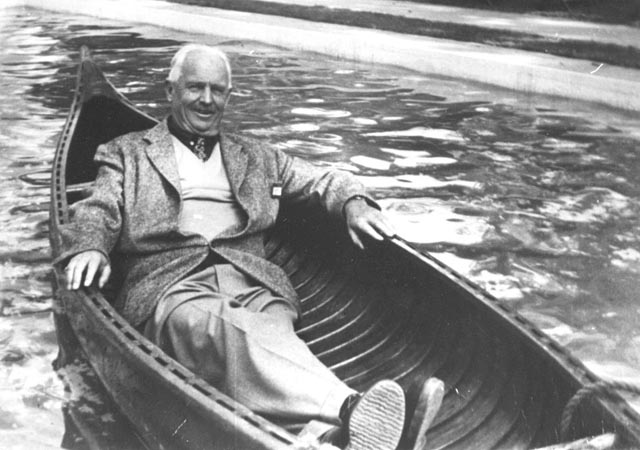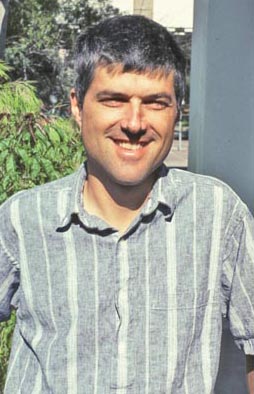SKETCHES
OF THE FACULTY OF THE
DEPARTMENT OF EARTH SCIENCE
UNIVERSITY OF CALIFORNIA, SANTA BARBARA
1938-2013
|
HENRY ALDRICH (1891-1979)
| |
Aldrich was Bob Norris' sabbatical leave replacement in 1961-62. He was a recently retired Editor in Chief and Executive Secretary of the Geological Society of America Bulletin and Society, respectively, and had served these roles for many years. Aldrich knew almost all of the leading American geologists and used to say that he was going to write a book titled "Famous Geologists That Have Known Me." Before his GSA service Aldrich taught at the University of Wisconsin.
|
RALPH J. ARCHULETA
|
Professor
Archuleta took his B.S. magna cum laude in physics at the University
of Wyoming in 1969, followed by his M.S. in physics at UC San
Diego. After taking his Ph.D. in Earth Sciences
at IGPP at Scripps Institution of Oceanography in 1976, and following
postdoctoral appointments in 1976-1978, Archuleta was a geophysicist
with the U.S. Geological Survey in Menlo Park until 1984 when
he accepted an appointment to the UCSB faculty.
Archuleta's
seminal work came with his research on the 1979 Imperial Valley
earthquake in southern California. With a publication in 1984,
Archuleta became the first seismologist to show convincingly that
an earthquake could rupture a fault at speeds faster than the
shear wave, a fundamental property of elastic materials. Prior
to Archuleta's research, most seismologists considered such behavior
to be a theoretical curiosity. These findings have significant
implications for seismic hazard analyses. Archuleta's work provides
insights into how the earthquake rupture process is directly linked
to the strong ground shaking experienced during an earthquake.
In
addition to his work with the Imperial Valley earthquake, Archuleta
has studied the effect of shallow sedimentary structures on strong
ground motion. In the early 1980's he installed borehole seismometers
at |
McGee Creek following the Mammoth Lakes earthquakes. He followed up
in the early 1990s when he installed the Garner Valley Downhole Array
that has provided crucial data for understanding the variations of acceleration
with depth near the surface. He later accepted responsibility for maintaining
two other California downhole arrays that had been installed by Kajima
Corporation of Japan. These downhole arrays, situated near the San Andreas
fault in northern California and between the San Jacinto and San Andreas
fault zones in southern California, provide essential data for estimating
seismic hazard.
While
conducting this critical seismological research, Archuleta also has
been an active leader in the seismological world, publishing 10 papers
in 2006 while serving as deputy director of the Southern California
Earthquake Center (SCEC). He led UC Santa Barbara's participation as
a founding member of SCEC in 1991. He later served as president of the
Seismological Society of America in 1997 and 1998. For his outstanding
contributions in seismology and earthquake engineering, the Seismological
Society of America (SSA) awarded Archuleta its top honor, the Harry
Fielding Reid Medal.
|
TANYA ATWATER, Professor
Emeritus
|
Professor
Atwater is a geophysicist and marine geologist who specializes
in plate tectonics, particularly the evolution of the San Andreas
fault plate boundary. Her educational work has focused on the
creation of computer-animated multimedia products and presentations
depicting plate tectonic histories.
Atwater
received her B.A. in geophysics from the University of California
at Berkeley in 1965. She
is a University of California, San Diego, Alumna, holding a Ph.D..
(1972) in Marine Geophysics from Scripps Institution of Oceanography.
She is presently a professor emeritus and Director of the UCSB
Educational Multimedia Visualization Center. She was a professor
at the Massachusetts Institute of Technology before joining the
faculty at UCSB in 1980.
She taught plate tectonics and introductory geology at
UCSB and was a staunch advocate and leader of the department's
Geo 18 field trip course.
Atwater's
research has concerned various aspects of tectonics, ranging from
the fine details of sea floor spreading processes to global aspects
of plate tectonics. She has participated in or led numerous oceanographic
expeditions in the Pacific and Atlantic Oceans, including twelve
dives to the deep sea floor in the tiny submersible, Alvin. She
is especially well known for her works on the plate tectonic history
of western North America, in general, and of the San Andreas fault
system, in particular, work that is presently taking her in exciting
new directions. Atwater is devoted to science communication,
teaching students at all levels in the University, presenting numerous workshops and field trips for K-12 teachers, consulting for the written
media, museums, TV and video producers, etc. Atwater serves on various
national and international
committees and panels. She is a fellow of
the American Geophysical Union and the Geological Society of America
and was a co-winner of the Newcomb Cleveland Prize of the American Association
for the Advancement of Science and was elected to the prestigious National
Academy of Sciences in 1997.
|
STAN AWRAMIK
|
Professor Awramik's interests center on understanding
the early history of life on Earth. The major focus is on the fossil
record during Archean and Proterozoic time, specifically on microbial
fossils and stromatolites. He conducts research on microfossils
from several pre-Phanerozoic formations, in particular the Gunflint,
Kingston Peak, and Doushantuo Formations. This research involves
establishing the microfossil's biogenicity, syngenicity (microfossil
is the same age as the primary sediment), taxonomic affinity, and
ecological context. These results are then added to a developing
picture of microbial evolution on the early Earth. He teaches historical geology.
|
ERNEST L. BICKERDIKE (1908-1987)
|
As a chemist, Professor Bickerdike offered the first geology course at Santa Barbara State College. He had minored in geology when a student at USC. He was chairman of the Department of Physical Sciences in 1959-60 before it was split into Physics, Chemistry, and Geology departments. He was Honorary Marshall of the UCSB campus in 1952, 1960, and 1961. |
JAMES R. BOLES,
Professor Emeritus
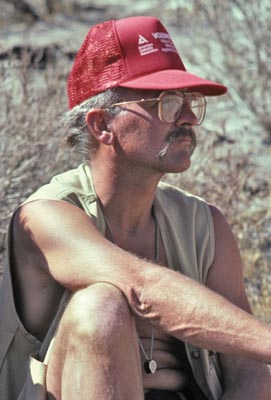 |
Professor
Boles took his B.S. degree in geology at Purdue University (1966),
his M.S. in geology at the University of Wyoming (1968), and his
Ph.D.. in geology at the University of Otago, New Zealand (1972). From 1973–1975, he was a Research Geologist with
the Atlantic Richfield Company in Dallas, Texas. Boles was on the UCSB faculty from 1975 to 2008 when he
retired from active service, and was department chairman from
1995 to 1997.
Boles
has been a consultant for ARCO, Texaco, Phillips, Chevron, Exxon,
Shell, Sohio, Amoco, Mobil,
City Service, Occidental, Koch
Exploration, Venoco, Murphy Oil and Gas, Signal Hill Petroleum,
Dames and Moore, Schlumberger, and Intratile.
His
research centers around clastic diagenesis primarily by detailed
petrographic and geochemical techniques. He has studied the timing of diagenetic events in California
Tertiary basins relative to hydrocarbon emplacement using isotopic
techniques combined with burial history and thermal models of
these basins.
Boles
taught introductory geology, geochemistry, field geology, and
sedimentary petrology. Now
he teaches his son how to drive race cars and shoot model cannons.
|
DOUG BURBANK
|
Professor Burbank took his B.A. degree from Reed College,
where his emphasis was in Literature. He took his M.S. from University of Washington in 1979, and
then his PhD. From Dartmouth College in 1982.
He taught at USC from 1982 until 1994, then at Penn
State from 1997 to 2000, coming to UCSB in 2001 to be the director
of the Institute for Crustal Studies.
Burbank's
research interests are manifold:
Tectonic geomorphology; active tectonics; structural and
stratigraphic evolution of fold-and-thrust belts and foreland
basins; physiographic evolution of mountain ranges; kinematics
of folding; basin analysis and modeling; analysis of digital topography;
sedimentology; magnetostratigraphy; fission-track dating; Quaternary
paleoclimatology; and glacial geology.
For the great impact of his research on the relationships among climate, erosion, and tectonics, Burbank was elected into the National Academy of Sciences in 2010. |
CATHY BUSBY
|
Professor Busby came from a Midwestern working class
family, and was the second person in her entire extended family
to attend college. She was identified as clearly different when
she taught herself to read at the ninth grade level by the end
of first grade, but it was not until her mid-twenties that she
found her way through a community college to UC Berkeley, where
she put herself through entirely on her own with the help of scholarships,
loans, work study, and a UC President's Undergraduate Fellowship.
After getting her PhD at Princeton University in 1983, she went
straight to a tenure-track position at UC Santa Barbara.
Before
she received tenure, she gave birth to one daughter, and before
attaining Full Professor she gave birth to twin daughters. They
are featured in many of the field photos she shows in conferences
and classes, and female students, interested in knowing how she
managed to combine motherhood with an academic career, often approach
her.
Busby
is a field geologist interested in tectonic reconstructions of
dominantly volcanic and sedimentary terrains using lab techniques
such as geochronology, geochemistry, petrography, and paleomagnetism.
She has published in a wide array of journals on a broad spectrum
of topics, including subaerial to deepwater volcanology, sedimentology
of active margins, economic geology, tectonophysics, structural
geology, petroleum geology, geochronology and geochemistry. |
JORDAN F. CLARK
|
Professor Clark received his B.S. from the Department
of Geology and Geophysics, Yale College, in 1988 and Ph.D.. from
the Lamont Doherty Earth Observatory of Columbia University in
1995. After completing a DOE Post-doctoral Fellowship
at Lawrence Livermore National Laboratory, he joined the faculty
UCSB in 1996. His appointment at UC Santa Barbara is split between
the Department of Earth Science and the undergraduate Program
of Environmental Studies. The program stresses the application
of science and technology in solving current environmental problems,
whereas the department examines fundamental processes that shape
the Earth's environment. These dual objectives, as represented
by his split appointment, form the basis of his scientific curiosity.
Clark's research focuses on understanding geochemical, hydrological, and
oceanographic interactions that occur near the Earth's surface
and the effects of external anthropogenic and climatic forcing
on these processes. It is united by a common set of questions:
how does transport affect water chemistry and quality, and what
are the impacts of climate change and other anthropogenic forcing
on water chemistry and flow. In particular his research addresses
1) how does groundwater transport solutes near Managed Aquifer
Recharge (MAR) sites, and what are the effects of multiple flow
paths on water quality; 2) why are gases transferred to the water
table below spreading ponds at MAR locations without significant
interactions with soil air; 3) what is the fate of methane and
other gases emitted by natural marine seeps, and how do bubble
plume processes enhance the transfer of these gases to the atmosphere;
4) does groundwater contribute significantly to the chemical weathering
of mountain catchments and can the weathering signal be used to
date baseflow; 5) what are the effects of long-term sea level variations on
the flow patterns in coastal aquifers? |
JOSEPH C. CLARK
|
Professor
Clark took his doctorate at Stanford and joined the UCSB faculty as
Acting Assistant Professor in January 1965. His interests were in stratigraphy, paleontology, and paleoecology.
He
resigned his UCSB appointment in 1972 and returned to Pennsylvania to
manage his family's estate. There he was a faculty member at Indiana
University of Pennsylvania from 1972 to 2004. He taught courses in environmental geology and subsurface geology
and contributed to the understanding of California fault zone geology
and earthquake hazards in central California through his work with the
U.S. Geological Survey.
|
PRESTON CLOUD (1912-1991)
|
Professor Cloud was born in West Upton, Massachusetts, and grew up in Waynesboro,
Pennsylvania, where he developed a love for the outdoors. Following
his high school graduation, Cloud spent three years in the United
States Navy (1930-1933) where he excelled at boxing.
In
spite of the difficulties of finding employment during the Great
Depression, Cloud paid for his own first semester at The George
Washington University in Washington, D.C.
But Ray Bassler, a professor and the curator of paleontology
at the National Museum of Natural History noticed Cloud's interest
in his work and arranged for him to work at the museum. Cloud
later worked with G. Arthur Cooper, a paleontologist and stratigrapher.
Under Cooper, Cloud learned much about fossils, especially brachiopods.
He worked full-time at the museum and then graduated in 1938,
earning a Bachelor of Science degree from The George Washington
University. Cooper financially supported Cloud while he was
a graduate student at Yale University, where he worked with Carl
Dunbar and earned his Ph.D. in 1942.
In
1941, Cloud joined the U.S. Geological Survey's WWII mineral exploration
program to study manganese deposits in Maine. He became director of the Alabama Bauxite Project the following
year. In 1943, he
joined the Texas Bureau of Economic Geology and worked on the
Ellenburger Project that studied the stratigraphy and sedimentation
of the Ellenburger carbonate complex.
He accepted a position as professor invertebrate paleontology
in Harvard University in 1946, but returned to the USGS in 1949,
where he became chief of the Branch of Paleontology and Stratigraphy.
In 1961, Cloud accepted a professorship at the University
of Minnesota and was appointed chairman of the Department of Geology
and Geophysics and head of the School of Earth Sciences. |
Cloud came to UCSB from UCLA as Professor Biogeology
in 1968 and set up the Biology Clean Laboratory to receive and study
rock samples from the Moon in a search for evidence of life. The lab is named in his honor. His active research included work on all
phases of life processes as related to the geologic and geochemical
record, especially in pre-Phanerozoic time, as well as interrelated
evolutions of the biosphere, atmosphere, hydrosphere, and lithosphere
of the developing Earth. He
also developed courses concerning geology as related to man and the
environment, including Resources and Man, Adventures in Earth History,
and Paleobiology.
When
Cloud arrived at UCSB, he was one of only two members of the National
Academy of Science on the campus. Cloud was a member of the National
Academy for 30 years; he was chairman of the Geology Section and occupied
positions in its Council and Executive Committee.
Cloud
received numerous awards and honors during his illustrious career, including
the Penrose Medal from the Geological Society of America in 1976, the
Charles Doolittle Walcott Medal from the National Academy of Sciences
in 1977, the Paleontological Society Medal, the L.W. Cross Medal from
the American Philosophical Society, the A.C. Morrison Award from the
New York Academy of Sciences, the Rockefeller Public Service Award,
and the Distinguished Service Award and the Gold Medal from the U.S.
Department of the Interior.
|
JON COTTLE
|
Professor
Cottle's main research interests lie in the field of continental
tectonics and focus on combining structural analysis, geothermobarometry,
igneous and metamorphic petrology with high resolution U(-Th)-Pb
isotope geochronology to identify and determine the temporal and
spatial scale of processes that modify and/or produce new continental
crust. He is particularly interested in the metamorphic, magmatic
and tectonic evolution of the Ama Drime Massif and Everest Himalaya
in southern Tibet and the TransAntarctic Mountains.
|
JOHN CHAMBERS CROWELL,
Professor Emeritus
|
Professor
John Crowell, a graduate in geology in June 1939 from the University
of Texas, is a general geologist who has spent most of his professional
career on the faculty of the University of California, first for
20 years at UCLA, and subsequently for 21 at UC Santa Barbara.
After
graduating from UT, Crowell undertook graduate work at UCLA, military
service in WWII (as an oceanographic meteorologist he forecast
the sea, swell, and surf for the Normandy Invasion and other landing
operations), and worked for Shell Oil Company in Ventura as a
field geologist. He obtained his MA in oceanographic meteorology from Scripps
Institution of Oceanography in 1946 and his PhD in geology from
UCLA in 1947 where he was a student of James Gilluly.
Crowell
came to UCSB from UCLA in 1967.
He served as graduate advisor from 1969 to 1972 and, with
Preston Cloud, founded the Environmental Studies Program.
He taught courses in structural geology, field studies
in tectonics, and graduate seminars in structure and tectonics.
Crowell's
research contributions are primarily concerned with sedimentation,
tectonics, paleoclimatology, and the regional geology of California. In the early and mid 1950s he published
several papers dealing with the origin of submarine canyons and
turbidity currents. In
California and the Alps he studied the characteristics of flysch-type
sedimentation. During the 50s and 60s he worked out the
displacement history of some of the major strike-slip faults in
California, including the San Gabriel and southern stretch of
the San Andreas. |
His work of the tectonic and sedimentation history
along the San Andreas transform belt formed the basis for the contribution
about the nature of these processes along similar tectonic belts, such
as those in the Caribbean region, southeast Asia, Australia, the North
Sea region, and the Alps. His
interest in downslope sliding processes, in California as well as in
Europe, led him to study the origin of pebbly mudstone and to discriminate
between these downslope deposits and those laid down by continental
glaciers. In the late 60s
this interest led into investigation of the record of ancient glaciations
in Europe, North American, and especially on all of the Gondwanan continents
in the Southern Hemisphere. He
has therefore studied glacial stratigraphic sections on all continents
in order to work out the history and causes of continental glaciation
through geologic time.
Among
his many honors are membership in the US National Academy of Sciences,
fellowship in the American Academy of Arts and Sciences, the Penrose
Medal and the Career Contribution Award from the Geological Society
of America, and an honorary doctorate from the University Louvain, Belgium.
About
his teaching career, Bob Norris said: "I believe you are the consummate university faculty member. It is hard for me to imagine a personality
better fitted to be a senior professor geology at the University of
California (or at any university for that matter!) You have shown us all that it is possible
to teach skillfully at all levels in the university and to convey useful
information to groups ranging from lower classmen to senior oil company
geologists, but I believe it is with graduate students you really perform
at your superlative best. For
what it is worth, I regard you as perhaps the ablest graduate level
instructor it has been my pleasure to know. Every graduate student working under your supervision has gotten
his or her full money's worth of intellectual stimulation, conscientious
supervision in the office and in the field. Not only that, you have made sure that they have gained experience
giving oral presentations of high quality and have been initiated into
the fine art of writing research funding proposals. The signal success of many of your graduate students testifies
to this most eloquent legacy."
Crowell
retired in 1987.
|
MICHAEL DENIRO
|
Professor Deniro took his Ph.D. at Caltech.
His
research involved study of the processes that cause stable isotopes
of hydrogen, oxygen, carbon, nitrogen and silicon to be distributed
differentially in biological systems, and applying understanding
of those processes to interpretation of stable isotope ratios
of fossilized biogenic materials.
He
now practices law in Santa Barbara. |
RICHARD V. FISHER
(1928-2002)
| |
Professor Fisher, or 'R.V.' as he was affectionately
known, was born on August 8, 1928, in Whittier, California. He
joined the U.S. Army in 1946, was assigned to Los Alamos National
Laboratory, New Mexico, and then volunteered for duty at Bikini
Atoll in the western Pacific. There he witnessed base surges generated
by underwater nuclear explosions, making observations that would
guide some of his pioneering research on pyroclastic density currents
years later. Toward the end of military service in 1947 he married
Beverly Taylor, his loving partner for the next 55 years. Four
children stemmed from their marriage.
Fisher
entered Occidental College in 1948, graduated with a B.S. in geology
and went on to graduate work at the University of Washington in
Seattle (Ph.D., 1957). His doctoral research on volcanic and sedimentary
strata southwest of Mount Rainier unraveled the complex mid-Tertiary
geologic history in that segment of the Cascade Mountains' volcanic
arc and led to his lifelong interest in stratigraphy, pyroclastic
volcanism,and volcaniclastic sedimentation. His papers from that
period on the classification of pyroclastic and volcaniclastic
deposits and rocks helped create and define a rational volcanic
terminology still in use today. |
In 1955,
Fisher accepted a faculty position in geology at the newly established
Santa Barbara campus of the University of California. His teaching and
research there during 1955-1969, when he rose to full professor, spanned
the turbulent period when UCSB evolved from a small liberal arts college
to a research university and major campus in the UC system. The doctoral
program in geology established at UCSB in 1964 has since produced many
well-known volcanologists (and other geologists), many of them mentored
by Fisher.
At
UCSB Fisher began work on ignimbrites of the John Day Formation in eastern
Oregon, laying groundwork for his later insightful studies on pyroclastic
density currents. He began his work with Aaron Waters on tuff rings
at maar-type volcanoes in the 1960s, first in eastern Oregon and then
in the Azores and other localities worldwide. NASA supported this work
because some lunar craters resembled maar volcanoes, whose creation
on the Moon would imply the presence of water. It was learned during
the Apollo program that the lunar craters were of meteorite-impact (not
hydrovolcanic) origin, but the maar research led to early ideas about
terrestrial explosive hydrovolcanism by R.V., his students, and colleagues.
Volcanic "base surges" arising from large-scale explosive
eruptions where rising hot magma interacted with water or wet sediments—much
like base surges produced by the underwater nuclear explosions witnessed
by Fisher at Bikini Atoll in 1946—were shown to be responsible.
Those ideas, in turn, led to his research into all types of pyroclastic
density currents (PDCs), many associated with caldera-forming pyroclastic
flows. His research on the May 18, 1980 blast deposits at Mount St.
Helens and elsewhere helped to resolve controversy regarding dense-flow
versus dilute, turbulent-flow models for PDCs. His field studies in
the United States, Italy, Germany, France, Argentina, Portugal, Spain,
Mexico, and China, including team efforts with his graduate students
and other colleagues, have addressed and clarified those and other important
problems of explosive volcanism.
Fisher
enjoyed writing, and his professional output was enormous. This includes
more than 80 articles in professional journals and related scientific
publications. His first book, Pyroclastic Rocks (Fisher & Schmincke,
1984) was and remains the definitive work on that topic. His next two
books, Volcanoes - Crucibles of Change (Fisher, Heiken, & Hulin,
1997) and his autobiography Out of the Crater - Chronicles of a Volcanologist
(Princeton University Press, 1999), both directed toward educating the
public, have enjoyed great success.
Fisher
was also a distinguished teacher, especially of graduate students, and
he launched many successful careers. He was a strong advocate for the
proposition that the best research scholars make the best teachers and
he lived up to that standard. He had the uncanny ability to challenge
students and get them enthused, yet doing so in an easy, friendly, laid-back
way. More than most, he inspired long-lasting loyalties.
Administratively,
Fisher served UCSB well. Three times he chaired the Department of Geological
Sciences (1969-73, 1979-80, and 1983-84) and he served several times
as its graduate advisor and as director of the Summer Field Camp. He
served also as assistant to the chancellor for Academic Planning (1972-73).
Outside the University he was a consultant to NASA and a member of many
national and international scientific boards.
Important
honors came his way. He received Senior Scientist Awards (1980-81, 1988-89)
from the Alexander von Humboldt Foundation of Germany, a prestigious
scientific recognition. For research achievements he won the N.L. Bowen
Award of the American Geophysical Union (1985), its highest award for
research in volcanology. This was followed (1997) by the Thorarinsson
Medal, the highest honor of the International Association of Volcanologists
(IAVCEI).
|
MIKE FULLER
|
Professor
Fuller received his B.A. and PhD from the University of Cambridge
in 1958 and 1961, respectively.
He then took a post-doctoral position at Scripps Institution
of Oceanography for a year and then moved to Pittsburgh to Gulf
Research and Development Laboratory for about two and a half years.
At this time Professor Takesi Nagata was starting a paleomagnetism
group at the University Pittsburgh's Department of Earth and Planetary
Sciences. Fuller joined Nagata and Kobayashi there in 1965. After Professor Koybashi returned to Japan,
Fuller ran the group with Nagata until 1974 when he came to UCSB.
Fuller's
research interests at UCSB were in the area of magnetism and its
applications to geology, lunar sciences, and biomagnetism. The particular focus areas were in the processes of magnetization
of rocks and the behavior of their constituent magnetic minerals,
paleomagnetic records of secular variation and field reversals,
lunar magnetism, paleomagnetism and tectonics, especially in China
and southeast Asia.
Fuller
retired from UCSB and then joined the faculty at the University
of Hawaii. |
PHIL GANS
|
Professor Gans came to UCSB in 1988 with a PhD from Stanford University.
His
interests lie in the general fields of structural geology and
tectonics and are focused on deformational and thermal processes
within the continental lithosphere. His research is mainly in
the field of extensional tectonics and is focused on exactly how
continents rift and the relationship between extension and magmatism.
Gans
makes most of his observations and draws much of his scientific
inspiration from field-based investigations. His research projects
generally involve detailed geologic mapping of critical areas
followed by appropriate laboratory measurements (e.g., radiometric
dating, geochemical analyses) and numerical modeling in order
to understand the structural and/or thermal process under study.
Recent work has focused on the Cenozoic evolution of the Basin
and Range province of the western U.S. and on the origin of Cretaceous
gneiss domes in Arctic Alaska and northeast Russia. Current and
future studies will expand on these themes and will focus on the
evolution of the Mexican Basin and Range province and the structural
evolution of gneiss domes on the Tibetan plateau. |
ROBERT GARRISON,
Professor Emeritus
|
Professor Garrison came to UCSB in fall 1965 as a Lecturer
in Geology. His undergraduate
training was at Stanford, graduate work at Innsbruck and Princeton,
and post-doctoral research at Princeton. His specialties were carbonate petrology and sedimentary basin
analysis. While at
UCSB his research involved electron-microscopic studies of fossils
and textural features of limestone from the Franciscan Formation
in California, and of nannoplankton from Pacific Northwest limestone.
He
also held a year-long teaching appointment at the University of
British Columbia before joining the faculty at University of California,
Santa Cruz in 1968, where he is presently Professor Emeritus of
Marine Oceanography, and Adjunct Professor, Moss Landing Marine
Laboratories. |
Conrad
D. Gebelein (1945-1978)
(from CALISPHERE,
8 December 2008)
|
The
son and grandson of prominent musicians closely associated with Johns
Hopkins University, Professor Gebelein received a bachelor's degree
in biology-biochemistry and a master's degree in biological oceanography
from Johns Hopkins. He went for the Ph.D.. degree at Brown University,
where his dissertation study of modern carbonate tidal flat environments
on Cape Sable, south Florida, was to become a modern classic. At the
time of his death, he had already published an impressive sequence of
major contributions to the field of biogeology. Through his analytical
studies and comparisons of modern and ancient marine environments, he
became a major contributor to the understanding of the enigmatic sedimentary
structures known as stromatolites. In large part, his efforts have transformed
them from mere geologic curiosities into keys to understand early paleoenvironments.
He had a gift for identifying significant problems, going to their centers,
and finding solutions.
In
1970 Gebelein began his study of the sedimentology and stratigraphy
of the southwest Andros tidal flats, a program that was still expanding
at the time of his death. He even organized an Institute for Marine
Sciences to pursue his goal of understanding the geochemistry and diagenesis
of tidal flat, reef, and oolite shoal environments, and the biogeology
of sponge and bryozoan bioherms in the Great Bahama Bank. This work
remains to be completed, but he gave it great momentum in constructive
directions.
|
His
professional appointments advanced from instructor and assistant professor
at the State University of New York at Stonybrook, to assistant director
of the Bermuda Biological Station, and then, in 1974, to Associate Professor
of Geology at UC, Santa Barbara.
Conrad Gebelein was only thirty-two and in apparently superb
health. His death from natural causes on the night of February 28 in
Nicolls Town, Andros Island, Bahamas was a great shock and a great loss.
He was buried at sea in the Tongue of the Ocean off Andros, according
to his own earlier expressed wish. The loss of a scholar of such promise,
in the full vigor of a career well launched, was a staggering blow to
his colleagues, his students and his science.
|
BRADLEY R. HACKER
|
Professor Hacker took his B.S. with honors (1982) and
M.S. (1984) at UC Davis and Ph.D. (1988) at UCLA. He held postdoctoral and research positions at Stanford University
from 1989 to 1996 in petrology, geochronology, and structural
geology before joining the UCSB faculty in 1996. Prior to his academic endeavors, Hacker was a programmer, technical
writer, and editor for Apple Computer (1978-1984).
Hacker works on theoretical and field studies of the rates
of phase changes and tectonics. Fieldwork emphasizes the integration
of geochronology, petrology, and structural geology. Current work
in China and Norway on the exhumation histories of ultrahigh-pressure
rocks builds on previous work on crustal extension and ophiolite
emplacement in Oman, Tibet, and the western US.
Hacker's current theoretical modeling focuses on the role
of phase transformations in intermediate-depth earthquakes. He
developed a new synthesis of the fate of water in the deep Earth,
showing that water, in the form of hydrous minerals in terrigenous
sediments, altered volcanic rocks, and lower crustal rocks, is
transported downward into the deep Earth in variable amounts along
subduction zones.
At UCSB Hacker teaches courses in metamorphic petrology
and intermediate field geology.
He was elected to Fellowship
in AGU in 2010. |
RACHEL M. HAYMON, Professor Emeritus
|
Professor
Haymon took her B.A. in geology at Rice University in 1976, followed
by her Ph.D. in oceanography in 1982 at Scripps Institution of
Oceanography.
Haymon
explores and characterizes hydrothermal systems along the global
Mid-Ocean Ridge and studies hydrothermal mineralization to determine
interrelationships among hydrothermal and other (magmatic, tectonic,
biological) ridge crest features/processes.
She investigates the nature, time-scales, and causes of
spatial and temporal variability in ridge crest hydrothermal systems
by conducting both geologic mapping studies and geochemical/ petrologic
studies.
At
sea and in ophiolites, Haymon maps, images, and samples fine-scale
geologic and hydrothermal features over entire ridge segments.
The seagoing mapping and imaging surveys are done using deep-towed
camera/sonar systems and deep-diving submersibles. Data acquisition
is followed by computerized image analysis and spatial analysis.
Haymon's research is interdisciplinary and problem-oriented, and
her students use a wide range of tools and creative approaches
to tackle unsolved mysteries of submarine magma/hydrothermal systems,
mid-ocean ridges, and mineral/microbe interactions.
Haymon became emerita July 2010. While retiring from active teaching she
continues her research on the workings of mid-ocean spreading centers
especially with respect to their hydrothermal systems..
|
CLIFFORD HOPSON,
Professor Emeritus
|
Professor
Hopson grew up in Marin County, California, known for its numerous
outcrops of the Franciscan Formation that formed one of the research
cornerstones of his career.
He received his BA at Stanford in 1951, Ph.D. from Johns
Hopkins in 1955, and became an assistant professor there in the
same year. He came
to UCSB as Associate Professor of Geology in September 1964.
Hopson
is a petrologist interested in igneous and metamorphic rocks and
related aspects of geochemistry and geochronology. His enthusiasm and well-organized courses did much to get the
department's graduate program off to an excellent start. Much of his research was on the granitic
and metamorphic rocks of the northern Cascades in Washington,
the geology of Mt. St. Helens before it erupted in 1980, and on
ophiolites in the California Coast Ranges and in Oman. |
CHEN JI
|
Professor
Ji is an earthquake seismologist who took his B.S. degree at Peking
University in 1991, his M.S at the Institute of Geophysics, Chinese
Academy of Science, in 1994, and his PhD. at Caltech in 2002.
His
research efforts focus on exploring the physical processes of
large earthquakes with various modern geophysical observations,
such as broadband seismograms, high-rate GPS, and radar interferometry.
Current work include developing a real-time finite fault inversion
system to quickly evaluate the catastrophic tragedies caused by
large shallow earthquakes globally, and determination of the lateral
variations of crustal structures using seismic waveform modeling
techniques. He teaches
geophysics and seismology at UCSB where he has been since 2003. |
DAN KARIG
|
Professor
Karig took his PhD at Scripps in marine tectonics and came to UCSB
in 1971 but left for Cornell University in 1973.
His research focused on island arc systems and theoretical
aspects of plate tectonics.
He taught geophysics, marine tectonics, and helped the Environmental
Studies Program with a course called Geological Problems of the
Human Environment.
|
EDWARD A. KELLER
|
Professor Keller took his B.S. in math and B.A. in geology
at Cal State Fresno. He took his M.S. at UC Davis (1969) and
Ph.D.. at Purdue University in geology (1973). He taught geomorphology, environmental studies, and Earth science
for three years at University of North Carolina before coming
to UCSB in 1977, where he has a split appointment between Earth
Science and the Environmental Studies Program.
Keller's research in active tectonics has centered on the western
Transverse Ranges of southern California through geomorphologic
investigations. The objectives of that research are to: 1) Establish
the late Pleistocene through Holocene chronology; 2) Estimate
rates of recent tectonic activity; 3) Determine the basic tectonic
framework of the western Transverse Ranges; 4) Provide a better
understanding of mountain-building processes in active fold-and-thrust
belts; 5) Understand fault and fold growth, particularly lateral
propagation and 6) Understand the earthquake hazard of the Santa
Barbara area. His hydrologic studies focus on: 1) Basic river
processes; 2) The role of wildfire and the recurrence intervals
of high magnitude flood deposits and debris flow deposits; 3)
Role of large woody debris on channel form and process; 4) Environmental
effects of channelization; and 5) River restoration and management.
|
JAMES P. KENNETT,
Professor Emeritus
|
Professor Kennett was born and received his early education
in Wellington, New Zealand. The wonderful geologic exposures of
his native country, especially the Nelson area where his grandparents
farmed, fostered a boyhood interest in geology. He received B.S.
and Ph. D. degrees at Victoria University of Wellington where
he began to meld his interests in Cenozoic stratigraphy, micropaleontology
and the Antarctic with marine geology.
Henry
Pantin from the New Zealand Oceanographic Institute convinced
Kennett about the importance of the oceans for understanding global
geology. At that time the United States was clearly well ahead
in this frontier research. For this reason he and his wife Diana
emigrated to the United States in 1966 largely to participate
in the post Sputnik excitement and opportunities in science of
the time. Jim had a postdoctoral fellowship with Orville Bandy
at the University of Southern California where he continued working
on Antarctic paleoclimatic history.
He
began teaching at Florida State University in Tallahassee –
a career spanning almost five decades of research and teaching
at FSU, the Graduate School of Oceanography, University of Rhode
Island and University of California Santa Barbara. The academic
environment at the Graduate School in Rhode Island for 17 years
was critical in advancing his experience in oceanography and marine
geology.
Kennett's
work in marine geology and paleoceanography since the middle 1960s
contributed toward comprehensive understanding of major paleoceanographic
and biotic changes that shaped the Cenozoic Era and its stratigraphic
record, and their underlying causes. Because of these
contributions, Kennett is considered a pioneer in developing |
paleoceanography as a new field and was founding editor of Paleoceanography.
In
1987, Jim moved with Diana to the University of California Santa Barbara
as Director of the Marine Science Institute, serving for 10 years and
also joining the Geology Department as Professor. On arrival at UCSB
he initiated two research projects near the campus but with potential
global implications. The first involved drilling and piston coring sediments
in Santa Barbara Basin to better understand Quaternary climate change
and its causes. The second was to push this record back through time
using the locally uplifted and exposed Cenozoic sediments, especially
the Miocene Monterey Formation. The 600-meter-deep Santa Barbara Basin
is remarkable in containing a fine stratigraphic record with layers
that can be divided as closely as single years, a phenomenon equivalent
to tree rings in the ocean. For millions of years this region has been
a highly sensitive recorder of climate change influenced by two competing
currents, the cold California Current from the north and the warmer
Countercurrent from the south. An abundance of microfossils adds to
the record's quality.
In
the early 1990s, the Ocean Drilling Program, successor to the Deep Sea
Drilling Project, drilled a site in the basin, providing a gold mine
of paleoclimatic information for last ice age. This provided Kennett
and colleagues with a picture of surprisingly abrupt climate and oceanic
changes, in turn raising the tantalizing question as to their triggering
and feedback mechanisms. Thus we now know that the Earth's climate is
highly prone to abrupt and major change, and therefore we need to be
careful how we manage our planet that can be decidedly fickle in its
behavior.
While
at UCSB Kennett taught a range of courses about oceanography, Antarctica,
geological oceanography, Earth System History, stratigraphy, paleoceanography
and micropaleontology. He has been blessed with association of many
wonderful graduate and undergraduate students and senior colleagues
at UCSB and earlier locales who helped discover much about how our Earth
has operated in its past.
Jim
Kennett formally retired from teaching and administration in 2006 with
the express purpose of actively focusing on various research projects.
|
DAVID LEA
|
Professor Lea was born in Philadelphia, Pennsylvania,
which explains why he is a diehard Phillies fan. He took his B.S. magna cum laude in geology (honors) at Haverford
College, and then his Ph.D. at Woods Hole (MIT) in 1990.
Lea is Professor of Earth Science and member of the Marine Science
Institute at UCSB where he has been a faculty member since 1989.
His research interests include climate change, global warming,
climate evolution during the Ice Ages, marine geochemistry and
the carbon cycle.
Lea
has been a Visiting Professor at the University of Chicago and
University of Cambridge, UK. His awards include the UCSB Academic
Senate Distinguished Teaching Award (2001), a John Simon Guggenheim
Fellowship (2002-03), a Leverhulme Visiting Professorship, a Clare
Hall Visiting Fellowship (both 2002-03, Cambridge, UK), the American
Geophysical Union Cesare Emiliani Lectureship (2007), and a Leopold
Leadership Fellowship (2009). He chaired UCSB's 2007 Global
Warming-Science and Society Event Series, which drew over
3000 attendees. Lea was named a Jefferson Science Fellow for 2010-2011.
|
LORRAINE LISIECKI
|
Professor Lisiecki took her B.S. at MIT in 1999, and
then took M.Sc. degrees at both MIT (2000) and Brown University
(2003), and then her Ph.D. at Brown in 2005.
She was appointed to the faculty at UCSB in 2008 where
she teaches graduate seminars in paleoclimatology.
Her research focuses on computational approaches to
the interpretation of paleoclimate records, because she believes
that the integrated analysis of widely distributed paleoclimate
records will yield important information about the climate system
that cannot be obtained by studying these records individually.
Liseicki is particularly interested in the evolution of Plio-Pleistocene
climate as it relates to Milankovitch forcing, 100-kyr glacial
cycles, and deep-ocean circulation. She also develops and distributes
software related to age model development and stratigraphy, using
such tools as stratigraphic correlation, simple physical models,
dynamic programming, and mathematical tools, including time series
analysis, principal component analysis, and computational probability
and statistics.
Lisiecki
received the 2008 Suburu Outstanding Woman in Science Award.
|
BRUCE
P. LUYENDYK, Professor Emeritus
|
Luyendyk is Professor of Marine Geophysics at UCSB,
past chair of the Department of Geological Sciences (1997-2003;
now Earth Science) and founding director of the Institute for
Crustal Studies (ICS), which he directed from 1987 to 1997. He
has been Associate Dean of Science at UCSB since 2005. Luyendyk
has been on the faculty at UCSB since 1973. He holds a Ph.D. from the Scripps Institution
of Oceanography at UC San Diego and was on the scientific staff
of Woods Hole Oceanographic Institution for four years prior to
coming to UCSB. His
research specialties include marine geology and plate tectonics.
Professor Luyendyk has been active in Antarctic research
since 1989, having made six expeditions to Marie Byrd Land and
the Ross Sea along the Pacific coast of Antarctica to study climate
history and the formation of mountain ranges. In 1994, along with former student Scott Hornafius, he began
an effort that has developed into a major research study of the
Coal Oil Point marine hydrocarbon seeps offshore from the UCSB
campus. He and his students were the first to recognize the ninety-degree
clockwise rotation of the Transverse Ranges and other regions
of southern California, which they described in a series of publications
from 1979 through 2001. In 1979 Luyendyk, along with Professors
Atwater, Haymon, and Macdonald, were members of the expedition
that discovered the deep-sea hot vents on the East Pacific Rise
with the submersible ALVIN.
Professor Luyendyk has taught courses in geophysics, on
Antarctica, and most recently on global petroleum resources.
He has been an active member of the Academic Senate serving on
Graduate Council, and the Council on Planning and Budget where he was
chair of the space sub-committee. |
| Luyendyk has received awards from the National Science Foundation,
the U.S. Navy, and shared the 1980 Newcomb Cleveland Prize of the American
Association for the Advancement of Science. He is a Fellow of the Geological Society of America and also
a Fellow of the American Geophysical Union. He retired from active teaching and administration in 2010.
|
KEN C. MACDONALD, Professor
Emeritus
|
Born
beneath the Golden Gate at the Presidio in San Francisco in 1947,
Professor Macdonald went to elementary, junior high and high schools
in San Francisco area; all three located on active traces of the
San Andreas fault system (Hayward fault).
As an undergraduate Regents Scholar at U.C. Berkeley in
Engineering Sciences during the tumultuous sixties [1966-1970],
he took a weekend field geology course as an elective.
The visiting professor taught the course in such a way
that the students discussed and saw at first hand the effects
of plate tectonics in the Franciscan complex in the mornings,
and sampled the fine wines of Napa and Sonoma counties in the
afternoons. This experience combined with his love
of the ocean and scuba diving diverted his interests away from
considerations of graduate work in engineering, medicine, or business
to oceanography.
Armed
with an NSF graduate fellowship, Macdonald decided to pursue graduate
studies in marine geophysics in the then new MIT-Woods Hole Joint
Program in Oceanography.
His wanderlust found him on many expeditions, including
seagoing voyages to Australia, New Guinea, Vanuatu, Samoa, Tahiti,
Galapagos, the Red Sea and the Azores. For his dissertation he participated in
a deep-tow expedition to the Mid-Atlantic Ridge led by Bruce Luyendyk
(then at Woods Hole) and Fred Spiess (at Scripps). Since he was
working with deep-tow data from Scripps Institution of Oceanography,
he found himself wintering in La Jolla to work with Fred Spiess
and Bob Parker, thus escaping the hellish winters on Cape Cod.
The summers were great because he lived on a cabin cruiser
he purchased for $400; it was anchored 1/2 mile south of Woods
Hole in a veritable floating village of seafarers.
|
Macdonald
was prepared to continue his summers on Cape Cod, winters in La Jolla
indefinitely, but, alas, the dean at MIT was not so prepared especially
once he noticed Macdonald had been without a PhD advisor for two years;
Luyendyk, his advisor, had left Woods Hole for UCSB and Atwater had
just arrived at MIT, in time to sign off on his dissertation.
Frantically
trying to finish his PhD in the three months before funding ran out,
Macdonald had failed to take time to look for a job. He was saved by the generosity of Cecil Green (founder of Texas
Instruments) who funded his first post-Ph.D.. job as Green Scholar at
the Institute of Geophysics and Planetary Physics in 1975 where he could
continue his association with Scripps and U.C. He had four very fruitful and enjoyable years at Scripps before
U.C. Santa Barbara lured him away with an offer of a tenured faculty
position in 1979. He was
concerned that seagoing geophysics at UCSB might be difficult because
UCSB lacked a ship, but he found that his colleagues at Scripps and
Woods Hole were open to continued collaboration. He also forged a fruitful
and fun-filled research partnership with his good friend Jeff Fox at
University of Rhode Island, a world's expert on oceanic transform faults. As a result, the 30 years at UCSB were rich with exciting research
opportunities and excellent graduate students. In 1984 he married former Scripps graduate student, Rachel Haymon,
who was Professor at UCSB where Macdonald is now Professor Emeritus.
Macdonald chaired
the Graduate Admissions Committee for nearly 20 years trying to enlarge
and invigorate the department's graduate program. He taught the large
Introduction to Oceanography class for about 20 years; also Introduction
to Geophysics, Marine Geophysics and Earth System Science. He taught the first seagoing field course, "Field Studies
in Marine Geophysics" in 1981 and continued that effort for over
20 years. Typically 10-15
undergraduates and 3-6 graduate students joined him on seagoing expeditions
(funded by National Science Foundation or Office of Naval Research)
for 1-2 months as a part of this 12 unit course. He was active in the Marine Sciences Institute and worked to
recruit its new director at that time, Jim Kennett. Macdonald was also the first sommelier for the departmental wine
collection (donated by alumus Rich Migues), a task he reluctantly gave
up when he retired in 2007.
Over
the last 35 years Macdonald's research focused primarily on the mid-ocean
ridge, the most active geologic feature on the planet, using available
geophysical or geologic tools to study the tectonics of this complex
system. He participated
in some of the first fine-scale explorations of the ridge, using swath-mapping
sonars, remotely controlled vehicles and manned-submersibles. He contributed to several important discoveries and advances
in understanding ocean ridge systems including: the fundamental segmentation of mid-ocean ridges and the significance
of ridge-axis discontinuities with overlapping spreading centers and
propagating rifts; the processes responsible for the creation and deformation
of oceanic crust particularly through the study of marine magnetic anomalies
and quantitative geomorphology; and the importance of hydrothermal vent
systems to the heat balance of the ridge. Macdonald was co-chief scientist
[with Fred Spiess] of the expedition that discovered the first "black
smoker" vents on the East Pacific Rise, sharing the 1980 Newcomb-Cleveland
Medal and Prize of American Association for the Advancement of Science
for that discovery. He
made over 50 dives in the submersible ALVIN to depths exceeding 8,000
feet.
In
retrospect Macdonald sees that his living condition is embedded in plate
tectonics. He continues to live on the same transform plate boundary
system on which he was born and raised [the San Andreas], he spends
summers in a cabin over a major subduction zone [in the Cascade Mountains],
and he works on divergent plate boundaries, the mid-ocean ridges.
In
his new status as Professor Emeritus, Macdonald continues to conduct
research on mid-ocean ridges and lectures on occasion, but more time
has been devoted to his other passions: windsurfing, fly-fishing, and supporting environmental organizations.
|
KEITH MACDONALD
|
Professor Macdonald received his Geology B.Sc. from University College, London (1961) and his Ph.D. from Scripps Institution of Oeanography (1967). He came to UCSB in 1968 after completing a post-doc at Yale's Peabody Museum of Natural History. His research interests bridged paleobiology and present-day shallow marine sedimentary environments. He taught a popluar Introduction to Oceanography course, paleontology and paleoecology classes, and obtain NSF support for a Non-Parametric Statistics course. His NSF grant to study biogenic structures in the Santa Barbara Basin funded the Department's first purchase of x-ray equipment to study sediment slabs. He was also active in the study of newly protected 'wetland' habitats and supported both geology and biology students studying Goleta and Carpinteria marshes.
Dr. Macdonald left UCSB in 1976 to pursue interdisciplinary research in the private sector. He headed NOAA's data synthesis team for the Alaska Outer Continental Shelf Environmental Assessment Program; studied circulation and shelf-edge coral hardground communities along Florida's Gulf Coast; and multidisciplinary studies of fjordal systems near Juneau, Alaska. His coastal wetlands studies contributed to protection and enhancement of Bolsa Chica wetlands, Batiquitos Lagoon, and South San Diego Bay.
Dedicated to the memory of Bob Norris, colleague, mentor, and friend.
|
YORK MANDRA
|
Professor York Mandra taught the department's Summer Session courses in introductory geology and energy and environment for many years. He took his B.A. and M.A. degrees at UC Berkeley and his PhD. at Stanford University. He was a post-doctoral fellow at the University of Glascow and Universite d'Aix-Marseille. He was on the San Francisco State University faculty from 1954 to 2005 where he taught courses in micropaleontology and Society Problems of Energy. In 1977 Professor Mandra was the recipient of the Robert Wallace Award that is presented occasionally by the Far Western Section of the American Geological Institute for sustained excellence in Earth Sciences teaching and sustained exceptional service to the Earth Science teaching profession. He was a fellow of the California Academy of Sciences and of the Geological Society of America. |
JAMES M. MATTINSON
,
Professor Emeritus
|
Professor Mattinson took his B.A. and Ph.D. (1970) in geology at UCSB where, among many other awards and honors, he was a Woodhouse Scholar.
He joined the UCSB faculty as an assistant professor in 1977.
His
research focuses on two major areas of isotope geology: application
of geochronology and radiogenic isotope tracer studies to problems
in tectonics and igneous and metamorphic petrology; and advancement
of understanding of the commonly complex behavior of the U-Pb
system in zircon, one of the premier geochronology minerals.
Mattinson
has provided technological breakthroughs in zircon dating that
are now being employed by the best labs around the world. Using
clever combinations of annealing zircon grains and chemical dissolution,
Mattinson discovered ways to reduce the sources of error in zircon
ages. His techniques result in radiometric ages that have much,
much smaller uncertainties than previously possible.
Mattinson
taught the gamut of courses over the years, including introductory
geology, mineralogy, igneous petrology, geochemistry, summer field
geology, and graduate courses in geochronology.
He retired in 2009. |
BRUCE NOLF
 |
Among other teaching assignments, Bruce Nolf taught the department's first few summer field courses with Don Weaver. Shortly afterward he took a position at Central Oregon Community College in Bend, Oregon, where he continued his studies of volcanology. |
ROBERT M. NORRIS,
Professor Emeritus (1921-2012)
|
|
Professor Norris was born in Los Angeles in 1921 when
it was smaller than San Diego or San Jose are today. His early education was in the Los Angeles public schools.
In the depths of the depression the family moved to the
mostly rural San Fernando Valley, and that fall he entered UCLA
as a chemistry major.
Providentially
between semesters in winter break in 1940, Bob and a high school
friend went on a trip led by Bob Webb to the pegmatite quarries
in San Diego County and thence to the Salton basin.
This was a life-changing experience, so that once back
at UCLA, he wasted little time in changing majors.
By
1942 the draft was about to convert Bob into a soldier, so he
enlisted in a Navy Officers training program instead and was instructed
to stay at UCLA until he had earned his degree, awarded in October
1943.
Naval
duty was in the Pacific aboard a small, but sea-going landing
craft ultimately involved in the invasions of Iwo Jima and Okinawa. Before he was discharged, Bob had some duty in Okinawa, Taiwan,
and mainland China.
Like
many of his former UCLA classmates, Bob returned to UCLA for a Masters
degree. His was supervised
by M.N. Bramlette and involved mapping an area south of Lompoc. Another fortuitous event occurred when
department chairman James Gilluly stopped Bob in the hallway and offered
him a teaching assistantship. Although teaching had never entered his mind, experience as a
TA, which included occasional substitute lecturing for Professor U.S.
Grant IV, settled the question.
|
Conversations
with Grant and Webb made it clear that the PhD degree was necessary
for a position in a 4-year college, and Grant suggested Scripps where
the field of marine geology was just getting started. To hedge his bets a bit, Bob completed course work for a junior
college teaching credential before going off to La Jolla to work under
the supervision of Francis P. Shepard.
The
PhD degree was awarded in June 1951 and shortly thereafter, Bob had
interviews at Santa Barbara. Although
he was chosen among his competitors (Jack McGill and Warren Hamilton)
for a new position, Berkeley refused to authorize his appointment at
that time because the post-war bulge in enrollment had passed.
Fortunately,
Francis Shepard had just been awarded a big American Petroleum Institute
grant to study recent sedimentation on the Gulf Coast at two locations: the Mississippi delta and the barrier
islands and shallow bays near Rockport, Texas. Shepard needed two party chiefs and Bob was chosen for the
Rockport area and led two field teams, one in the summer of 1951 and
the other in the winter of 1952. Bob and his new wife, Ginny, had a honeymoon of sorts in Texas
during the winter season.
|
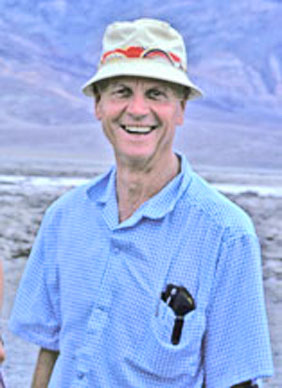 |
During
spring, 1952, Bob Webb, having transferred from UCLA to UCSB,
went on sabbatical leave to Washington, DC.
Bob replaced him as a member of a two-man geology section
in the Department of Physical Science, the other member being
C. Douglas Woodhouse. Once
the geology "unit" became the Department of Geology,
Bob became its first chairman from 1960 to 1964.
During his long UCSB career, Bob taught the introductory physical
geology course, geomorphology, geology of California, and the
spring field mapping class in Tick Canyon.
The Robert M. Norris Prize in Field Geology honors his
teaching efforts in that course.
He also organized and taught the first University of California
course in marine geology outside of Scripps.
This course led his student, Bob Ballard, discoverer of the "Titanic",
to a career in marine exploration.
From 1970
to 1975, Bob was Director of the Santa Cruz Island Field Station
when all of that island, except its eastern end, became part of
the University of California's Natural Reserve System.
In 1981, Bob
received the Neil Miner Award from the National Association of
Geology Teachers for "exceptional stimulation of interest
in the geologic sciences", the highest award conferred by
that organization.
Also in 1981 he was the recipient of the Robert Wallace Webb Award that is presented occasionally by the Far Western Section of the American Geological Institute for sustained excellence of Earth Sciences teaching and sustained exceptional service to the Earth Science teaching profession.
His
research centered around geomorphology, especially sand dunes and shoreline
erosion problems. While
on sabbatical at the New Zealand Oceanographic Institute, he led three
cruises that investigated Holocene shelf sedimentation. He was also a member of the International Geophysical Year
"Downwind Expedition" off the west coast of South America
(1957-58), including Easter Island.
|
BRIAN PATRICK
|
Professor Patrick joined the UCSB faculty in 1991 as a metamorphic petrologist and his PhD from the University of Washington. He returned to that state in 1993. |
SUSANNAH PORTER
|
Professor Porter was exposed to geology at an early age. Her father, Stephen Porter, studies Quaternary climate change, and as a teenager she accompanied him as a field assistant to the Big Island of Hawaii and to the Qinghai Plateau and Inner Mongolia regions of China. Susannah received her bachelor's degree in mathematics from Yale University in 1995 and her Ph.D. at Harvard University in 2002, where she studied paleontology with Professor Andrew Knoll. After Harvard, Susannah completed a one-year NASA Astrobiology Post-Doctoral Fellowship at UCLA, and started at UCSB in 2003.
Susannah's research focuses on the early fossil record of animals and their protistan relatives. She has worked on problems relating to the early evolution of skeletal biomineralization, the influence of "snowball Earth" glaciations on the diversity of life, and the early evolution of eukaryotes. Her fieldwork areas have included central Australia, west Africa, southern and central China, and the Grand Canyon. At UCSB, Susannah teaches The Age of Dinosaurs, a large (>500-
student) lecture course for non-science majors, and three upper division courses: Principles of Paleontology, Invertebrate Paleobiology, and Early Life and its Environmental Context.
|
BILL PROTHERO, Professor
Emeritus
|
Professor Prothero was a physics major at Portland State
College and went on to get a Ph.D. in physics at University of
California, San Diego in 1967. He developed a very stable and
sensitive gravity meter consisting of a superconducting ball floating
on a superconducting magnet. It was used to measure gravity variations
over month to year long time scales. He then went to the Institute
of Geophysics and Planetary Physics on the San Diego campus, where
he developed a program to study earthquakes in remote ocean areas
using seismic stations deployed from ships. These stations had
to record their own data on the seafloor for as long as a month,
then return to the surface on command.
Prothero
joined the UCSB faculty in 1976 and continued his ocean seismic
work by measuring earthquakes in the Santa Barbara Channel and
various California regions. Beginning in about 1993, he decided
that the new microcomputer technology showed exciting promise
for improving undergraduate education, particularly for non-majors,
and he was awarded numerous National Science Foundation grants
that enabled him to focus on that effort exclusively. This work
provided general education oceanography students with "point
and click" access Earth data and to use their analyses to
write science papers. Just like scientists, students reviewed
each other's work and learned about how science works. He retired
in 2005 and is still writing educational software and working
with science teachers around the world, an example of which can
be seen at http://learningwithdata.org/
He's
not all work, though. During graduate school, he was an avid surfer,
a passion that has now morphed to windsurfing on the Columbia
River. He is also studying jazz piano and rides his bicycle to
keep in shape during the non-windsurfing winters in Santa Barbara. |
JAN RIETMAN
|
A geophysicist, Rietman joined the UCSB faculty in 1966
but left for a position in industry (EG & G) in 1970. He specializes
in the 3D interpretation of seismic reflection surveys for tunneling
and fault investigations.
|
BOB ROACH
|
Bob Roach took his PhD at the University of Cardiff, Wales. He was a hard rock petrologist who specialized in ultramafic rocks, such as charnockite. After his one year appointment at UCSB in 1959-60, he returned to the UK and spent his career as a faculty member at the University of Keel in Staffordshire. |
CHARLES W. ROCK
| Rock
was an Associate at UCSB in 1962-63, then became a Lecturer in Geology
in January 1964. He was
a graduate of Princeton University and spent many years in Saudi Arabia
with Aramco before coming to Santa Barbara, where he revitalized the
elementary geology laboratories and developed a reputation as an outstanding
teacher.
|
DON RUNNELLS
Geochemist Runnells arrived at UCSB in 1967 and then
moved on to the University of Colorado in 1969.
GEOFF SHAW
|
Shaw was Public Information Officer of the New Zealand Geological Survey with an MSC degree from Auckland University. He taught Geology 2 and freshman labs in 1962-63. |
RICHARD H. SIBSON,
Professor Emeritus
|
Professor
Sibson graduated BSc (Hons) in Geology from the University of
Auckland and then obtained his PhD from Imperial College, London,
on the structure of the Outer Hebrides thrust fault in northwest
Scotland. He taught
at Imperial College (1973-1982), and was then invited to the United
States Geological Survey (USGS) in California and spent an "intoxicating
6 months" there. "They were incredibly generous,"
he says, "giving me access to a great deal of seismological
data they had accumulated but hadn't yet interpreted." It
was during this period that he was able to correlate the depth
distribution of earthquakes in the crust with the fault zone models
that he had developed.
Moving
to the University of California at Santa Barbara (1982-1990) Sibson
continued to look at fault zones – trying to understand
the dynamics of fault processes and how fluid movement at depth
tied into fault instability. He returned to New Zealand in 1990
as Professor of Geology and chairman of the Geology Department
in the University of Otago, retiring in 2003.
Sibson's
research, described as "varied and intellectually profound",
includes broadly structural geology, seismotectonics, earthquake
science, rock mechanics, metamorphism, hydrothermal flow through
fractured rock, but with a particular focus on fault-related mineralization
and coseismic fault processes. Through integration of these disciplines,
he has made internationally significant scientific advances on
the structure, mechanics, and mineralization of crustal fault
zones in relation to earthquake source mechanics. A current focus is fault-controlled fluid
redistribution in different tectonic settings. Sibson has authored
80 research papers and has contributed short courses to
the mineral industry in Australia, Canada, the United States,
Chile, South Africa, and Europe. |
Professor
Sibson attributes his life-time love of the outdoors to early excursions
with his father, a "schoolmaster, bird-watcher, and inveterate
island-hopper". His subsequent career choice, he says, was influenced
by his uncle Sir Charles Fleming, paleontologist and naturalist, and
also a Fellow of the Royal Society, who gave him "a gentle nudge
in the direction of geology."
In
2003 he was accorded the rare honor of election to Fellowship of the
Royal Society of London in recognition of his scientific achievements,
together with the Distinguished Research Medal of the University of
Otago.
At
UCSB Sibson delighted in teaching structural geology and the Poleta Folds part of summer
field geology.
|
ALEX SIMMS
| Simms took his BS degree at Oklahoma State University
in 2001 and then his PhD at Rice University in 2005. He returned to OSU as Assistant Professor following his PhD
and then agreed to join the UCSB faculty in 2009. He specializes in siliciclastic sedimentology/stratigraphy,
Quaternary science, coastal geology.
|
FRANK J. SPERA
|
Soon
after Frank Spera was born in Philadelphia, Pennsylvania, in 1950,
he showed early interest in the outdoors by collecting plants,
frogs, and rocks. He grew up on the venerable Wissahickon Schist,
a pelitic, medium-grade metamorphic rock, and thus was fascinated
by the veins and folds and minerals of this unit that literally
cropped out in his backyard.
He recalls fondly the first time he correctly identified
a museum standard sample of kyanite found in the woods behind
the family house.
But Frank had little interest in formal schooling. In fact he 'hated' elementary and junior high school. Instead, he could not wait to return home,
whip out his chemistry set to do experiments, or go to local quarries
and hunt for minerals, or mix up chemicals in search for the perfect
rocket fuel. Thus Frank's early interests in physics, chemistry,
and biology - anything science - he lived for.
Then "Sputnik" went up when he was 8, thus that
crystallizing his interest in planets and the Earth as a planet
An
influential 6th grade teacher got him started on the road to geology,
and by 10th grade he was reading college books in physics, geology,
chemistry, and calculus.
Then finally around 10th grade it all came together and
he realized that he would have to worry about grades if he wanted
to get into college.
At
the same time Spera also realized that geology includes all the
other sciences, so he matriculated at Franklin and Marshall College
in 1968 and majored in geology. Between his junior and senior
year, a summer of geologic mapping project in the Klamath Mountains
of California was another pivotal event for young Frank, in that
he mapped the Coast Range thrust with the high grade blueschist
rocks, which, unbeknownst to a 'dumb kid from philly', Gary Ernst,
the 'high priest' of ophiolitic rocks, had already studied a decade
earlier. |
Franklin
and Marshall had some great teachers, great geology was exposed in the
Valley and Ridge, and the Piedmont was nearby to explore and make maps.
Additionally, Franklin and Marshall was strictly an undergraduate college,
so Frank and fellow students had offices, use of college vehicles for
weekend sojourns, and unlimited use of labs and many other college facilities.
Spera took his B.A. degree in geology there in 1972.
Spera started graduate school at UC Berkeley in fall 1972, obtained
his PhD there in igeous petrology and geochemistry in 1977, and then
went directly to Princeton University as assistant professor, receiving
tenure there in 1983. He remained at Princeton until July 1986 when
he was lured to UCSB.
At
UCSB he has focused his research on thermodynamics and fluid mechanics
of igneous melts to learn about the physics and chemistry of the Earth's
mantle and core. He has also delved into the volcanic hazards of southern
Nevada. His UCSB courses include igneous petrology,
an introductory course about the solar system, and mineralogy. |
ARTHUR G. SYLVESTER,
Professor Emeritus
|
Professor Sylvester is a general geologist with primary
interests in structural geology and neotectonics.
His publications and technical reports have dealt with
the petrology and emplacement mechanisms of granitic plutons in
Norway and eastern California, the deformation of minerals in
thermal aureoles of plutons and thrust faults, the structure and
deformation history of uplifted blocks along the San Andreas fault
zone, and vertical movements of active and potentially faults
in southern California, western Nevada, and western Wyoming.
In addition, he has published papers on the volcanic history
of parts of the North Atlantic, earthquakes in southern California,
occurrences of rare fossils in eastern California, and morphotectonics
of southern Italy.
Sylvester was born and raised in southern California and
received his A.B. degree in liberal arts from Pomona College in
1959. He was a Fulbright
Scholar at the University of Oslo, Norway, where he matriculated
in 1961 and did the field work on the VrĆdal pluton that formed the basis of his M.A. thesis at UCLA in 1963. He continued in geology at UCLA under the supervision of Clem Nelson, Gerhard Oertel, and John Christie, collaborating with them on the comprehensive study of Papoose Flat pluton. His part of that work, the structural and metamorphic petrology of the country rocks around the pluton, was the subject of his PhD dissertation in 1966.
Early in his career he was a research geologist for the
Shell Development Company. There he was introduced to the tectonics of strike-slip faults and, together with Robert R. Smith, developed the concept of "palm-tree structures" ("flower structures" in the parlance of the Exxon Corporation that developed the idea separately and simultaneously). Their study of the San Andreas fault in the Mecca Hills generated Sylvester's interests in neotectonics and ultimately in tectonic geodesy.
Sylvester became a member of the geological
faculty at UCSB in the days before affirmative action; indeed his interview for the position consisted solely of lunch with Bob Webb and others in the darkened backroom of Bray's 101 restaurant. His tenure in the department lasted 35
years,
|
and in that time he was Chairman of the Department for five years. He taught courses in field geology at the introductory,
intermediate, and advanced levels, structural geology, introductory geology, and neotectonics. He took a break in 1972-74 to be Director of the University of California's Scandinavian
Study Center at the University of Bergen, Norway, where he was associated with Bergen's Seismological Observatory in a study of the surveillance and prediction of volcanic eruptions in the North Atlantic.
Sylvester was a Distinguished Lecturer for the American Association
of Petroleum Geologists in 1984, served as director of that association's
Structural Geology School for three years, and was an associate editor
for AAPG Bulletin for four years. With Tor Nilsen, he led AAPG's field
seminar in Exploration of Strike-slip and Rift Basins from 1989 to 2005.
In 1994 he received Coast Geological Society's Distinguished Teaching
Award in Education. He
was the Science Editor of the Bulletin of the Geological Society
of America for six years from 1989 to 1995 and received the Society's
Distinguished Service Award for that work.
In 1995, Sylvester was a Fulbright Research Scholar at the University
of Oslo, Norway, where again he studied the emplacement and evolution
of granitic plutons in southern Norway. He continued and broadened that work as a Norwegian Research
Council Fellow in 1996. While
in Norway, Sylvester presented a V. M. Goldschmidt Lecture to the Norwegian
Geological Survey, a lecture series named in honor of one of the foremost
geochemists of this century. Also
in 1995 he received the University of California's Presidents Award
for Excellence in Undergraduate Research Mentoring, and in 1997 the
UCSB Academic Senate's Award for Distinguished Teaching in the Mathematical,
Physical, and Life Sciences. The UCSB graduate students in geology
honored him with their Faculty Member of the Year award in 1999, and
the undergraduate students did so, too, in 2000. Sylvester is a Fellow
of the Geological Society of America, and a member of the American Association
of Petroleum Geologists, the Coast Geological Society, the Seismological
Society of America, and the Society of Sigma Xi. He was a Registered Geologist in the State of California until 2010. |
TOSHIRO TANIMOTO
|
Professor Tanimoto took his B.S. (1977) and M.S. (1979)
at the University of Tokyo and his PhD in geophysics at the University
California, Berkeley in 1982. He was an assistant professor of
geophysics at the University of Washington (1984-1985) and at
Caltech (1985-1992) before coming to UCSB in 1992.
Tanimoto
is a theoretical seismologist specializing in wave theory and
analysis. He has developed new methods to visualize
seismic wavefields as they propagate across a region. By exploiting
the high density of seismic recording stations in southern California,
he illuminates how the underlying crustal structure interacts
with seismic energy to produce surface displacements.
Such information reveals the nature of rocks at depth as
well as spatial variations in surface expressions of seismic energy.
He
teaches courses in geophysics and inverse theory. |
Bruce
H. Tiffney
|
Professor
Tiffney is a native New Englander with a BS in Geology from Boston
University and a minor in Biology in 1971.
His Ph.D.. in Plant systematics, morphology and evolution
was from Harvard in 1977. Tiffney spent nine and a half years
in the Department of Biology and the Peabody Museum of Natural
History at Yale University where he taught evolutionary biology,
biogeography and paleobotany, and won the award for best teacher
in Science and Mathematics.
In
1986 he migrated to the west coast and the Department of Geological
Sciences at UC Santa Barbara where he's taught historical geology,
introductory paleontology, paleobotany and angiosperm systematics,
winning the award for best teacher in Math, Life and Physical
Sciences in 1998. More recently he has served as the Dean of the
College of Creative Studies.
Tiffney's
research intertwines evolutionary biology and the plant fossil
record on a number of levels. At the basal level of hard data,
he is an alpha taxonomist, working on the fossil record of angiosperms
as evinced by their fruits and seeds – one of perhaps a
dozen people on the planet with this specialization. Tiffney has
studied material from northern California, the east coast of North
America, Europe and Africa. These individual identifications join
data already in the literature to allow understanding of the patterns
of evolution and migration of angiosperm lineages in response
to climatic and zoological change through time. Thus Tiffney's
apparently narrow focus on fossil fruits and seeds has led him
to be a primary player in elucidating the paleobiogeography of
land plants in the last 65 million years and the initiator of
studies on the relationship between animal dispersers and plants
in the fossil record. That interest has in turn led to a further focus
|
on the evolution and dynamics of terrestrial ecosystems and the changes
that have occurred as plant and animal life have co-evolved in the broadest
sense since plants first came onto land. At the grandest level of enquiry, Tiffney has joined colleagues
across the field of paleobotany to develop a database of all known fossil
plant records that can then be used to examine patterns of diversification
and extinction and their relationship to biotic and abiotic stimuli.
|
GEORGE R. TILTON (1923-2010)
|
Professor
Tilton was born and raised in central Illinois. After three and half semesters at Blackburn College, a small
two-year school near St. Louis, Missouri, Tilton was drafted into
the Army in 1943 to service in WWII.
Upon discharge, he resumed his college career in 1945 at
the University of Illinois at Urbana-Champaign, where he graduated
with a bachelor of science degree with high honors in chemistry
in 1948. Upon taking his Ph.D. in 1951 at the University of Chicago
in geochemistry, Tilton then accepted a position as a physical
chemist and geochronologist at Carnegie Institution of Washington,
D.C., Washington, first in the Department of Terrestrial Magnetism
and later at the Geophysical Laboratory. Tilton joined the UCSB
faculty as Professor of Geochemistry in fall 1965 and retired from active teaching
in 1991.
Tilton
is regarded as the "father of uranium-lead geochronology"
for granitic rocks. His
paper "Uranium-Lead Ages" is a classic. With Claire Patterson, he dated the first rock ever to be analyzed
for its absolute age – a one billion year-old granite from
the Canadian Shield. He
led the pioneering studies that defined and refined methods and
applications for all isotopic systems, as well as on the uranium-lead
system, devising and confirming the basic procedures for analysis
that are still in use today. |
GEORGE TUNELL (1900-1996)
(Memorial
by Robert Learned, 2004: Geological
Society of America Memorials, v. 33, 57-61.)
|
"George
Tunell was born April 4, 1900, in Chicago, Illinois, where his
father, George Gerard Tunell, Sr., served as tax commissioner
and vice president of the Atchison, Topeka, and Santa Fe Railway.
He inherited his love of academic excellence and scientific rigor
from his father, who had earned his doctorate in economics from
the University of Minnesota. At the age of seven, during a trip
with his father, Tunell received a cigar box full of minerals
and ore specimens from a miner at Castle Hot Springs, Arizona;
thus began his lifelong interest in mineralogy.
"During
his school years, he was an avid visitor at the Field Museum of
Natural History in Chicago, and before he graduated from Evanston,
Illinois, Township High School in 1918, he had decided to pursue
the field of mining geology, so he applied for admission to Harvard
University. From 1918 until 1922, Tunell pursued a rigorous undergraduate
curriculum in the Engineering School of Harvard University and
graduated magna cum laude with a bachelor of science degree in
mining geology in 1922.
"As
a graduate student in Harvard University's Graduate School of Arts and
Sciences from 1922 to 1925, he focused his research on the field and
petrographic aspects of oxidized cappings of disseminated copper deposits.
His field studies began in 1922 at Tyrone, New Mexico, where he participated
in the landmark secondary enrichment investigations of Augustus Locke.
He conducted similar studies at Morenci, Arizona, in 1923, and at Bingham
Canyon, Utah, in 1924.
|
"Tunell
attributed his scientific successes in large part to the sound training
and constant encouragement of his professors at Harvard. Among those
he was especially grateful to were Professor Graton in economic and
mining geology and Professor Bridgeman in thermodynamics. Honors received
while he was a graduate student at Harvard included the George H. Emerson
Scholarship and the John Harvard Fellowship.
"Although
Tunell left the Harvard campus in 1925, he continued his research in
oxidized cappings at Carnegie Institution's Geophysical Laboratory,
and in 1931 he received a doctorate in geology. His dissertation, "The
oxidation of disseminated copper ores in altered porphyry," constituted
a major contribution toward an understanding of the physico-chemical
genesis and mineralogic relationships in the supergene zone of porphyry
copper deposits. A copy of this work is to be found in the office of
virtually every porphyry copper mine.
"Tunell's
professional career began in 1925 at the Geophysical Laboratory in Washington,
D.C., where he served as staff petrologist until 1945. His early experimental
investigations there were related to his graduate work in field and
petrographic studies of porphyry copper deposits and were designed to
elucidate the physico-chemical basis of leached capping formation. In
collaboration with Eugene Posnjak, he determined the equilibrium relations
of tenorite and the basic and normal sulfates of copper in the system,
cupric oxide-sulphur trioxide-water (1929), the stability relations
of goethite and hematite (1931), and the stability relations of goethite,
tenorite, brochantite, and antlerite in the system: ferric oxide-cupric
oxide-sulphur trioxide-water (1931).
"While
he was conducting experimental studies related to supergene chemical
processes, Tunell became increasingly aware of the need for the application
of sound thermodynamic principles. Consequently, he began a series of
very fundamental studies in thermodynamic principles, an endeavor that
continued to interest him into his final years. Most of his thermodynamics-related
works were published under the auspices of the Geophysical Laboratory,
including those works published as late as the mid-1980s. Titles published
during his tenure at the Geophysical Laboratory included "Definition
and evaluation of the fugacity of an element or compound in the gaseous
state" (1931), and "On the history and analytical expression
of the first and second laws of thermodynamics and the role of the differentials
dW and dQ" (1932).
"Structural
crystallography of ore minerals was the focus of Tunell's research during
many of his years at the Geophysical Laboratory. His publications include
those on the crystal structures of tenorite (Tunell, Posnjak, and Ksanda,
1933), chalcanthite (Barth and Tunell, 1935), calaverite (Tunell and
Ksanda, 1935), krennerite (Tunell and Ksanda, 1936), sylvanite (Tunell,
1941), and bornite (Tunell and Adams, 1949). His work in X-ray crystallography
often led to pioneering innovations in methodology. For example, he
derived the Lorentz correction factor for equi-inclination Weissenberg
photographs (1939), and he and A.L. Patterson (1942) developed a method
for the summation of the Fourier series used in X-ray diffraction analysis.
His wife, Ruth, whom he married in 1931 during his tenure at the Geophysical
Laboratory, often ably assisted him with his Xray crystallographic investigations.
"During
his 20 years at the Geophysical Laboratory, Tunell received numerous
prestigious honors, including election to membership in the Washington
Academy of Sciences and to Sigma Xi. The Carnegie Institution designated
him as their official representative to the Seventeenth International
Geologic Congress in Moscow. Tunell was elected to the presidency of
the Geological Society of Washington, to the vice-presidency of the
Washington Academy of Sciences, and to the vice-presidency of the Mineralogical
Society of America. He was also granted the Naval Ordnance Development
Award for his wartime research on gun barrel technology.
"In
1945, Tunell left the Geophysical Laboratory and entered the academic
world at the California Institute of Technology in Pasadena, California.
He had applied for a temporary teaching appointment there, primarily
because of his and Ruth's health problems in the humid climate of Washington,
D.C. He served as visiting Professor of Mineralogy and Metalliferous
Geology at CalTech from 1945 to 1947, during which time he continued
his X-ray crystallographic studies and collaborated with Linus Pauling
on the crystal structure of gold-silver tellurides (1952).
"In
1947, Tunell and Ruth decided to remain in southern California. Upon
learning of the situation, James Gilluly, then Chairman of the Geology
Department at UCLA, promptly asked Tunell if he knew someone who might
be interested in an assistant professorship at UCLA. Sensing Gilluly's
embarrassment, Tunell answered: "Jim, if you're offering the position
to me, I accept it with pleasure." Within two years of the initial
appointment, he was awarded a full professorship.
"Although
research continued to be an important part of his endeavors, Tunell
considered his teaching responsibilities to be paramount. He was an
excellent teacher, as former students will attest, and his most highly
appreciated attributes were his depth of knowledge of the subject matter
and his unselfish sharing of time to impart that knowledge to his students.
He taught a broad range of subjects at UCLA, including courses in mineralogy,
optical mineralogy, X-ray crystallography, ore deposit geology, and
chemical thermodynamics.
"Tunell's
intense interest in the genesis of ore deposits continued unabated during
his years at UCLA, and his early interest in the genesis of mercury
ore deposits is clearly indicated in his address as retiring president
of the Mineralogical Society of America (1951). He and his graduate
students embarked on an extensive series of field, petrographic, and
chemical equilibrium studies that proved to be of significant relevance
to an understanding of the genesis of mercury ore deposits. Investigations
carried out during his UCLA years included solubility studies of cinnabar
and metacinnabar in aqueous sodium sulfide solutions (Dickson and Tunell,
1954, 1958), sulfur in aqueous sodium sulfide solutions (Arntson, Dickson
and Tunell, 1958, 1960), and stibnite in aqueous sodium sulfide solutions
(Arntson, Dickson, and Tunell, 1966). "The stability relations
of cinnabar and metacinnabar" (Dickson and Tunell, 1959) was an
equally important contribution to the series of these investigations.
"Fundamental
crystallography continued to occupy Tunell's interest. He published
a number of works during his UCLA tenure, including "The angle
between the a-axis and the trace of the rhombic section on the pinacoid
in the plagioclases" (1952), "Calculation of polar and direct
axial angles of triclinic crystals from interfacial angles" (1954),
and "A laboratory manual of crystallography for students of mineralogy
and geology" (Tunell and Murdoch, 1957).
"Likewise,
Tunell's interest in fundamental thermodynamics continued undiminished
at UCLA; his publications included "Evaluation of the chemical
potential in terms of intensive quantities" (1957) and "Relations
between intensive thermodynamic quantities and the first derivatives
in a binary system of one phase" (1960).
"Many
honors were bestowed upon Tunell during his years at UCLA. He served
as President of the Mineralogical Society of America, served two terms
as Vice President of the Geological Society of America, served as President
of the Branner Geologic Club of Southern California, and was honored
by the naming of a new mineral, "tunellite." His years at UCLA were very rewarding ones. He was greatly admired
and held in high esteem by fellow faculty members and by students alike. |
|
"In
1962, at his own request and that of the geology faculty at U.C.
Riverside, Tunell was transferred to UC Riverside, where a former
student, Professor Frank Dickson, and his graduate students were
conducting field, petrographic, and experimental investigations
related to mercury ore deposits. Many significant papers resulted
from those studies, including "Chemical processes in the formation
of mercury ores and ores of mercury and antimony" (Tunell,
1964), "Mercury and antimony deposits associated with active
hot springs in the western United States" (Dickson and Tunell,
1968), and "On the origin of the livingstonite deposits at
Huitzuco, Guerrero, Mexico" (Tunell, Learned, and Lawrence
1976). The research group at UCR conducted several chemical equilibrium
studies relevant to mercury ore deposits. Those studies included
orpiment in aqueous sodium sulfide solutions (Weissberg, Dickson,
and Tunell, 1966), cinnabar-quartz in aqueous sodium sulfide solutions
(Learned, Tunell, and Dickson 1967), quartz in aqueous sodium sulfide
and sodium hydroxide solutions (Learned, Dickson, and Tunell, 1966),
and cinnabar-stibnite in aqueous sodium sulfide solutions (Learned,
Tunell, and Dickson, 1974). "Tunell's
enthusiasm for teaching continued throughout his years at UCR, where
he taught courses in mineralogy, optical mineralogy, thermodynamics,
and ore deposit geology. Few teachers have shown greater understanding
of their subjects or greater interest in their students.
|
"During
his years at UCR, Tunell served as President of the Geochemical Society,
Vice Chairman of the Cordilleran Section of the Geological Society of
America, and gave invited lectures at the Sociedad Geologica Mexicana.
"When
Tunell reached the mandatory retirement age of 67, the University of
California honored him with the status of Professor Emeritus. He and
Ruth then moved to Santa Barbara, California, a locale that had attracted
Tunell since his boyhood days. The geology faculty at U.C. Santa Barbara,
realizing their good fortune, soon requested that Tunell be recalled
to active duty, and so began another long chapter in his teaching career
and one that he enjoyed immensely.
"Tunell's
enthusiasm for research remained strong during his nearly 30 years of
"retirement" in Santa Barbara. He discovered and determined
the crystal structure of a new mineral, gianellaite (Tunell, Fahey,
and Daugherty, 1977), and authored or co-authored six research papers
on the mineralogy and geochemistry of mercury ore deposits (Dickson
and Tunell, 1968), (Tunell, 1970), (Learned, Tunell, and Dickson, 1974),
(Tunell, Learned, and Lawrence, 1976), (Tunell, 1978), and (Rytuba and
Tunell, 1978). He also avidly pursued his lifelong research interest
in chemical thermodynamics and authored six fundamental publications
on the subject (1975, 1977, 1979, 1981, 1984, 1985).
"Honors
continued to be bestowed upon Tunell during these years in retirement.
He presented invited lectures on the geochemistry of mercury deposits
at Purdue University, The University of Madrid, Spain, and The University
of Ljubljana, Yugoslavia. The Mineralogical Society of America awarded
him its prestigious Roebling Medal. The Washington Academy of Sciences
invited him to present its annual J. Willard Gibbs lecture, and the
Robert A. Welch Foundation invited him to give presentations in its
lecture series.
"Tunell's
contributions to the fields of crystallography, thermodynamics, and
phase equilibria of aqueous systems related to ore genesis were truly
remarkable. As Gunnar Kullerud noted as he introduced Tunell at his
Roebling Medal presentation, 'All of the Tunell publications can serve
asmodels of systematic, careful, and imaginative experimental and theoretical
studies.
'"
Not
mentioned in this comprehensive memorial by Learned, but commonly known
by his students is that Tunell was a champion welterweight boxer at
Harvard University. But even more remarkable to the UCLA students who
knew Tunell and quaked in his dour, gruff, no nonsense presence, is
that he was a champion ballroom dancer. And although he seemed like
a gruff old man to this student, not infrequently could one detect a
twinkle in his eye that indicated a wry, deeply concealed humor and
a knowledge of things beyond most people's ken.
(ed.)
|
DAVID VALENTINE
|
Born
in San Diego, California, and raised in Davis by parents who both
worked for the University, Professor Valentine has not strayed
far from his UC roots. His higher education started with science
classes at UC Davis while still in high school, followed by a
BS degree in Chemistry/Biochemistry in 1995 and an MS degree in
Chemistry in 1996, both from UC San Diego. Life-long obsessions
with dirt, chemistry and the environment drew Valentine to study
sediment biogeochemistry at UC Irvine, in its newly created Earth
Systems Science program. He earned an MS degree there in 1998
and a Ph.D. in 2000. During his graduate work Valentine began
to appreciate the importance of microbes in Earth's elemental
cycles, and received a postdoctoral fellowship in microbial biology
from the National Science Foundation to pursue research at Scripps
Institution of Oceanography from 2000-2002.
Valentine
joined the UCSB faculty in 2001, where he conducts research at
the interface of chemistry, microbiology, and Earth science, specifically
investigating the roles of microbes in modulating Earth's elemental
cycles. Valentine's teaching has included Introductory Oceanography,
Earth Systems Oceans/Atmospheres, Field Studies in Marine Geochemistry
and a quarterly graduate seminar. His awards include an NSF CAREER
award in Chemical Oceanography and the 2009 Chancellor's Award
for Excellence in Undergraduate Research Mentorship.
See more about Professor Valentine's work at: http://www.methane.geol.ucsb.edu
|
JAMES W. VALENTINE
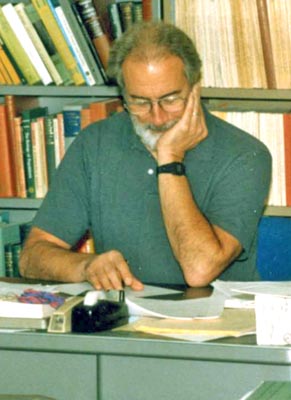 |
James W. Valentine is an American evolutionary paleobiologist
and Professor Emeritus in the Department of Integrative Biology at the
University of California, Berkeley. He was on the UCSB faculty from 1975 until 1990 when he was
inducted into the National Academy of Sciences.
Valentine
integrated study of the geologic and biologic events during the Precambrian-Cambrian
transition, in concert with a consortium of workers. He also had deep interest in the processes
of diversification that were responsible for the appearance of the very
unusual biosphere of the early Paleozoic. He is also interested in the
macroevolution of ecogeographic units (species' populations, communities,
provinces, etc.), especially with regard to diversity problems in marine
bivalves in the Cenozoic oceans. According to Valentine, this involves
"accumulating a database of the geographic and geologic ranges
of all genera and subgenera, and all species in certain local cases
through the last 65 million years..."
|
AARON CLEMENT WATERS
(1905-1991)
A Biographical Memoir by Clifford A. Hopson, 2007, National
Academy of Sciences (NAS), Biographical Memoirs: V.89, 368-391.
|
|
"Aaron
Waters was born in Waterville, Washington, on May 6, 1905, the son
of pioneer parents and the youngest of seven children. His early
years were spent on the family homestead and wheat ranch near Waterville,
on the western edge of the Columbia River Plateau in the shadow
of the Cascade Mountains. He worked on the ranch during his youth
and helped to run it at age 12 and 13 during the last years of World
War I, when his older brothers went off to war. Following graduation
from high school, Waters entered the University of Washington, supporting
himself by work in a gas station and other jobs. He began prelaw
studies but later changed to geology, partly from his love of the
out-of-doors but influenced especially by his college friend Richard
E. Fuller, who later became both a distinguished geologist and a
long-time director of the Seattle Museum of Art.
"Waters
earned a B.Sc. in geology (cum laude) in 1927 and an M.Sc. in
1928, both from the University of Washington. Waters continued
his studies at Yale University, known for its program in geology
and development of leaders in that field. He earned his Ph.D.
in 1930 under the mentorship of Professor Adolph Knopf. His dissertation
was "Geology of the Southern Half of the Chelan [30'] Quadrangle,
Washington."
"The
first taste of university teaching came during his doctoral studies
at Yale, where Waters served as instructor in the Geology Department
(1928-1930).
He accepted appointment as assistant professor
of geology at Stanford University and soon rose to professor and
remained at Stanford for 21 years (1930-1951).
|
"World
War II intervened, and Waters took leave from Stanford to join the U.S.
Geological Survey's expanded exploration program for strategic minerals,
deemed vital to the war effort. Mercury was among those essential metals
whose known reserves were limited, and Waters teamed with other volcanologists—mercury
ores being associated with volcanic and subvolcanic rocks—to improve
the inventory. His introduction to mercury (quicksilver) deposits had
begun in the prewar years in southwestern Oregon (1935), and these were
now the focus of his war-related fieldwork in Arkansas, Oregon, and
elsewhere in the western United States. Resulting U.S. Geological Survey
(USGS) publications appeared in 1951.
"A
brief return to ore deposits research came with Waters' participation
in the USGS' uranium exploration program on the Colorado Plateau (1951-1952),
where volcanogenic processes once again proved important (1953). Here
the search for magmatic sources of the strata-bound uranium ores led
to his collaboration with Charles B. Hunt on the petrology and petrogenesis
of subvolcanic rocks of the North La Sal stock and its laccoliths (1958).
"Waters
and close friend James Gilluly, then a professor at the University of
California, Los Angeles, and Professor A. O. Woodford of Pomona College,
had become disenchanted with the existing textbooks on introductory
physical geology, and began to write one of their own. The first edition
of Principles of Geology (1951), superbly illustrated by the skillful
drawings of Stanford colleague Robert R. Compton, was an immediate success.
This book, substantially improved in its second edition in 1959 and
its third edition in 1968, remained the leading physical geology textbook
for more than two decades.
"A
uniquely productive and happy period of Aaron Waters' career came with
his appointment in 1952 as professor of geology at Johns Hopkins University
in Baltimore, a position he held for the next 11 years.
"Waters
returned to his West Coast roots in 1963 by accepting a post in the
budding Geology Department at UC Santa Barbara, slated to grow into
a major University of California campus. He attracted new, research-oriented faculty members
who enlarged the department and enhanced its stature. Shortly afterward, he turned an
attentive ear to the offered opportunity to build a geological program
from the ground up at the UC's newest campus at Santa Cruz (UCSC). The
challenge proved irresistible and Waters transferred to UCSC in 1967,
plunging into the demanding task of building a department.
"Waters'
expertise in volcanology opened the way for a new, exciting field of
research and teaching during the Santa Barbara and Santa Cruz years:
lunar geology and exploration of the Moon's surface. With NASA's Gemini
Project to orbit the Moon, and the follow-up Apollo Project to land
on and sample its surface, an urgent need arose to learn more about
the geologic processes that had shaped the lunar surface and operated
within its interior.
"Retirement
from UCSC came in 1972 but with no letup in the pace of Waters' professional
activities. His university teaching continued, as did his geologic research.
Most notable was the near-completion of his beloved longterm project
on the geology of the Columbia River Gorge, separating Oregon and Washington
(1973). He also lent his expertise to federal research organizations
as a consultant in volcanology.
"Many
honors came his way, including a Guggenheim Fellowship (1937-1938),
election to the National Academy of Sciences (1964) and the American
Academy of Arts and Sciences (1966), and the Penrose Medal of the Geological
Society of America (1982), its highest award."
|
DON WEAVER, Professor
Emeritus
|
|
Professor Weaver was born in 1927 in the rural area of eastern Washington in a 3-room farmhouse without electricity or running water, delivered by a mid-wife. He was the 3rd of 9 children. He spent his childhood in the late 1920’s and early ‘30’s along the Oregon coast where his father was able to obtain work building the first bridges that made possible coastal road travel.
Life during the depression of the 1930’s was difficult but made tolerable by poaching wild game and pouching apples and other produce for food and canning. Don’s family moved to California in the late ‘30’s but he left home at the age of fourteen. After working on the swing shift in a steel fabrication plant in Oakland at the start of World War II, he joined the Contractors Pacific Naval Airbases in 1943 and was sent as a laborer to help rebuild the Naval Facilities at Pearl Harbor. Following his two brothers who had seen action in the Pacific, he joined the Marines in 1945 and trained for the anticipated invasion of the Japanese homeland. It was this early life experience that so affected his latent character development. Following the atomic bombing of Japan, Don was assigned to Military Police duties in Hawaii and Guam. He returned to the States in 1947 for the first of several leg surgeries, and fortunately met his late wife Helen, then the librarian at the Naval Hospital. They married and had three children.
|
Following his discharge in 1949, Helen tutored Don in English, German, and Polish. She had an MA from the University of Wisconsin and had majored in foreign languages (German, French and Polish). It was discovered that he had lifelong hearing problems, making it difficult to hear certain sounds and thus pronounce certain words. He made up high school deficiencies at a local college and entered UC Berkeley in 1950 with the financial aid of the GI Bill of Rights. He received his BA studying at Berkeley and Davis, emphasizing such diverse subjects as zoology, Wild Life Management (with the renowned Professor A. Starker Leopold), civil engineering, forestry, and agriculture. During the summer, Don worked in the heavy construction industry to earn extra money to support his growing family. He went on to earn an MA and Ph.D. in Paleontology and Geology studying with Professor Bob Kleinpell, who had close industrial contacts in the petroleum industry. It was these industrial contacts that led Don into a lifetime of industrial consulting, not only in the Petroleum Industry but also in Engineering Geology. He had close association with Dames and Moore, an international Earth science consulting firm, Exxon, Mobil Oil, and various engineering and agricultural organizations.
While working for Mobil and on his Ph.D. dissertation in the Santa Ynez Mountains, he visited the recently established Santa Barbara Campus of the University of California. The Department of Physical Sciences consisted of Chemistry, Physics, and Geology. Biology had been separated earlier and given its own building. The Geology Division consisted of three professors, the renowned Bob Webb from UCLA, Bob Norris, a graduate of Scripps, and the recently hired Dick Fisher, from the University of Washington.
Following a visit to Berkeley by Webb, where he met Don’s wife and family of three boys, Don was offered an Acting Assistant Professorship. Don still believes that Bob’s meeting with his wife was what got him the job! He joined the faculty in January 1959, completed his dissertation that fall and was awarded the Ph.D. in January 1960.
The Chairman of the Department was Ernest Bickerdike, a chemist, who informed Don that though he was a “Berkeley graduate”, he would be expected to mainly teach and do a modest amount of research. Bickerdike also asked if there were any jobs in paleontology or a future for paleontologists. It was made clear to Don that it would be wise to join the “church of his choice” and to sell the maroon Buick convertible he had inherited, as it was not very appropriate for an Assistant Professor! In those days the Applied Arts, such as Auto Mechanics, were still taught on campus, and faculty were asked to chaperone student dances. Don became the Faculty Advisor for the graduating class of ’64. The place was a college campus out of the ‘30s. He was expected to maintain his “industrial relations” as an asset in placing our graduates. Shortly thereafter with our first Masters degrees, Exxon and later Mobil Oil started recruiting at the campus and awarded the Department small unrestricted grants.
Don taught courses in Stratigraphic Paleontology, Historical Geology, Introductory Geology, and Field Geology. He was quite shy in lectures during the early years because of his life long hearing/pronunciation impairment, though he tried to hide it by not using certain otherwise common words. He failed at this at least one time when a student interrupted to ask what the word was that he had used. The student asked if the word was “bat tree” or “battery”. It was of course the latter, a word he had mispronounced all his life along with such words as "penny" and "aluminum".
In 1961 he initiated the first Summer Field class, joining Berkeley and UCLA in the White Mountains at the so-called Poleta Folds. In ’62 and ’63 with fellow instructor Bruce Nolf and department technician George Hughes, he founded the first independent Summer Field Camp for UCSB. He took the camp to Santa Cruz Island in ’64 and ’65, and later split it between the island and Poleta folds. He taught it nine times, though the excellent TAs largely ran it toward the end when his legs finally gave out. He concluded his island studies by successfully negotiating an agreement between the owner of Santa Cruz Island, Dr. Carey Stanton, and the Regents of the University of California for the establishment of the Channel Island Field Station as part of the University Land Reserve System. He subsequently served as its director for a number of years.
As his consulting practice matured, Don taught courses in groundwater and well design, engineering geology, as well as graduate seminars in Stratigraphic Paleontology. He held Work-Study shops in applied engineering geology where students worked part time on an industrial job such as water well design and construction, or land stability/sea cliff retreat problems, along with report preparation and seminar discussion. In his classes he often discussed professional ethics, and the distinction between ethics and morals.
His early collaborative research produced six monographic works published by the University of California Press on the Eocene and Oligocene foraminifers and mollusks from the Coast Ranges and Central Valley of California. These were often written in conjunction with his former professor and fellow students from Berkeley, who were now in the petroleum industry, and students from UCSB. Notable exceptions include: The Geology of the Northern Channel Islands, co-authored with Bruce Nolf, Dave Doerner, and students from the ‘64 and ’65 Summer Field classes and published by the Pacific Section of the AAPG; The Limits of Lyellian Series and Epochs, written at the University of Tübingen and published as part of the Colloque sur L’Eocene, Paris, May 1968; complete but unpublished manuscripts entitled Groundwater in California - Geology and the Law, co-authored with his son Mark, then recently graduated from Yale Law School; and The Miocene Stratigraphy in California Revisited.
These latter manuscripts were never published, largely for social and/or political reasons, as one might imagine from the subject matter. The Miocene paper, though primarily written by Don, was later revised and published by his old Professor and published by the AAPG. Ground water in California at the time was and perhaps still is a hot political subject. As the saying goes, “whisky is for drinking and water is for fighting over”. He was elected an Associate Member of the Society of the Sigma Xi, Devoted to the Promotion of Research in Science for his work in early Tertiary biochronology. He was active in the Pacific Coast Sections of the AAPG and the SEPM, which published several of his early papers. Following the 1969 Santa Barbara oil spill by Union Oil Company, he was asked to testify before the U.S. Senate Subcommittee reviewing the petroleum activity in the Santa Barbara Channel. An expanded version of his testimony was published in 1970 by Our Sun entitled Santa Barbara: An Overview.
During the Vietnam war years the campus was engulfed in a tumultuous era of numerous disruptions, both on and off the campus, at times deadly or potentially deadly. A bomb at the Faculty Club killed the caretaker, classes were disrupted, pins in the card files in the library were pulled and the cards scattered, students “captured” the new computer center, students demanded a vote at department meetings. Don was often quoted as saying the students wanted to "take a course in surgery without taking a course in anatomy”. Academic standards were difficult or impossible to maintain, and the faculty, administrators and students were all involved. Being an ex-Marine, Don was an outspoken supporter of the local ROTC program, which had come under attack. He was invited and attended seminars at Fort Lewis by the Department of the Army for briefings on the modern Army. He became a frequent speaker on problems at the University around the State, which were surreptitiously monitored by the administration. He was asked to join secret meetings with then Governor Reagan and an ad hoc committee of the Regents on academic deterioration. When he was invited to and testified at an open meeting of the Regents, he became persona non grata to the liberal elements on campus while being cheered on by the rare conservative elements. Subsequently his phone was removed from his office, preventing Regent Lawrence from reaching him, but thereafter the phone was “mysteriously” returned. He was increasingly threatened and harassed on campus and at home. Calls to his home were traced by the FBI. So much for so-called “academic freedom”. One member of the Regents suggested that he stay in the University but consider expanding his consulting practice, which he did for the remainder of his thirty-year tenure in the Department.
His “expanded” consulting practice, often involving graduate students, included such work as groundwater basin studies, the regional geology for the expansion of the plutonium facility at Los Alamos Scientific Laboratories, agricultural development of fruit, cattle, horses, and marketing for an offshore organization, water well location and design for the Western White House for now President Ronald Reagan, and retention by the FBI and CIA for limited stateside duty regarding academic unrest and oil reserves in China. His work for the oil industry expanded to Alaska, the West Coast, and Baja, Mexico, much of which continued to involve students when and where appropriate. He was pleased to find that these industrial contacts for the students often led to their employment by industry, whether it was in the petroleum industry, engineering geology, water exploration, federal and local government, or as individual private consultants.
His wife, friend, tutor and cultural better half passed away in 1984. Though emotionally lost for a few years, he was fortunate enough to eventually find and marry another multi-linguist, introduced by her German father as "a cultured lady and a good cook”. Ulli had taught German at the University and Santa Barbara City College and was an avid tennis player and lover of Bach.
Don retired from the University after 30 years, having served half of his time there as a more typical professor (though few students or colleagues would have called him “typical”) and half as a rogue, i.e. as a “spy” as he has been called, or as he prefers, the “eyes” for the politicians who oversee the University, the general public, and the federal government. He was not a cultured or classically educated person, but after WWII there were few professors who were. He enjoyed brown bagging it with professor “double LL” Willson, a Yale scholar and the founder of the local chapter of the Phi Beta Kappa Society. Larry often told of how the University had been invaded by GIs, educated under the GI Bill of Rights and who had been first class mechanics before the war, but were now second class engineers and professors, i.e. without a classical education. Larry did not realize that he was speaking about Don!
In retirement, Don continued to consult with industry and devoted 11 years advising on a pro bono basis the Conrad Hilton Foundation
|
|
|
CNHF, World Vision, members with Air Force One |
Weaver, Borlough, and Hilton |
Weaver with Mixtecs at CIMMYT |
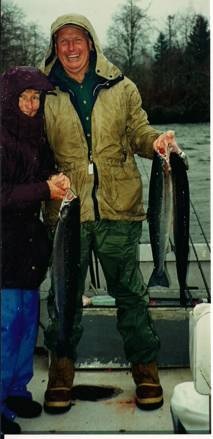 |
regarding water development in Ghana, West Africa, in conjunction with World Vision, and in southern Mexico. In Mexico, the CNH Foundation joined forces with the Ford Foundation to support the development of water supplies and improve agricultural crops for the Mixtecs of Oaxaca. Don was fortunate to work with the agriculture experiment station and reserve known as CIMMYT in Mexico, and meet and listen to the teachings of Nobel Laureate Dr. Norman Borlough with Steve Hilton. Dr. Borlough created the "Green Revolution" which was a transformation in agricultural practices between the 1960s and 1990s that doubled world food output and is believed to have saved up to a billion lives worldwide. Borlough began his career in Mexico after the Second World War, developing a new strain of wheat, which he took to other regions of the world along with new strains of rice, corn, and other crops. It was an early version of genetic engineering through cross breeding. Dr. Borlough was deeply involved in both Africa and Mexico.
Don says that he retired five times because it took him that many times to learn how to do it. He and Ulli finally left the consulting business and traveled worldwide hunting and fishing in Mongolia, Kazakhstan, Africa, New Zealand, Argentina, Uruguay, Mexico, Alaska, and British Columbia. He moved back to Oregon in 2003 to be near his “bride’s” grandchildren. He soon had to have new knees after undergoing six leg surgeries over the decades. Though he is through hunting, he lives along a good trout stream, manages his property and investments, plays tennis daily (if they hit the ball to him), and occasionally tries salmon or steelhead fishing on the great Oregon rivers. He sends Professor Hopson photos of his successes.
|
|
ROBERT WALLACE WEBB (1909-1984)
| Bob Webb was born in Los Angeles, California, November 2, 1909,
attended public schools there, graduating from Hollywood High School
in 1926. He entered the Southern Branch, University
of California (now UCLA) in the fall of that year to major in Spanish. However, he soon fell under the influence of William J. Miller
and changed his major to geology. He moved with the campus to Westwood in
1929, graduated in 1931, and for a brief time attended the University
of Washington. In fall
1931 Bob began graduate study at the California Institute of Technology
and received the M.S. degree in June 1932. During 1932 he also earned a general secondary teaching credential
from the University of Southern California. From 1932 to 1937, Bob simultaneously taught at UCLA and worked
toward his PhD at Cal Tech. The
PhD was awarded in 1937, and he accepted a full time appointment at
UCLA as Instructor in Geology.
|
|
In those days, most UCLA undergraduate geology majors were
expected to do a senior thesis, and it was Bob Webb who supervised
most of those students. Although graduate studies in geology began
at UCLA by 1940, and many of the faculty had begun to devote more
and more of their time to research and graduate instruction, Bob
believed in the fundamental importance of the undergraduate program
and devoted his considerable energy to make it rigorous, soundly
grounded, and up to date. Despite the fact that he supervised very
few graduate students during his long academic career, he was convinced
that a graduate program, once authorized, had to be a quality program,
taught by faculty with strong and active research interests.
Although graduate studies in geology began at UCLA
by 1940, and many of the faculty had begun to devote more and more of
their time to researchand graduate instruction, Bob believed in the
fundamental importance of the undergraduate program and devoted his
considerable energy to make it rigorous, soundly grounded, and up to
date. Despite the fact that he supervised very
few graduate students during his long academic career, he was convinced
that a graduate program, once authorized, had to be a quality program,
taught by faculty with strong and active research interests.
|
During World War II, Bob became deeply involved in university
administration and by 1945 headed the UCLA campus office of Veterans
Affairs, and the University-wide office in 1947. It was chiefly in this capacity that his administrative talents
became fully evident. In those days, the military services executed
numerous agreements with the University in connection with the many
training programs for officer candidates. On one occasion, a senior Army Office in charge of training programs
in southwestern United States announced that students enrolled in the
Army programs at UCLA would henceforth be expected to march between
classes. Bob insisted that that was inappropriate
at the University of California, and that the students at UCLA would
do no such thing, irrespective of Army sponsorship. Bob kept then University President Robert
Gordon Sproul informed, and President Sproul, for his part, pleased
with Bob's forthrightness and understanding of University traditions,
gave Bob his full support, and subsequent agreements with the Army included
no provision for marching between classes.
In his early days as a regular faculty member at UCLA, he was
famed for being the only junior assistant professor to rise on the floor
of the Academic Senate to question the judgment of President Sproul. Sproul, an open and forthright person himself, was quite intrigued
by the young, outspoken professor, and the two became life-long friends.
More and more of Bob's time was devoted to University administration
during the war years and early post-war years when he was Associate
Dean of the College of Letters & Science. Although he was prepared to give up his research endeavors, he
found it a good deal more difficult to put administration ahead of teaching
and undergraduate advising.
He watched with interest the entry of the Santa Barbara campus
into the University of California system in 1944 and inevitably became
acquainted with C. Douglas Woodhouse who taught the entire slate of
geology courses offered at Santa Barbara and who also served as campus
Veterans Affairs Coordinator. Bob saw that Santa Barbara offered an
attractive opportunity to limit his deepening involvement in administration
while simultaneously permitting him to influence strongly the development
of a new undergraduate major in geology in a University of California
setting.
Bob transferred to Santa Barbara in fall, 1948, despite attempts
of his UCLA colleagues to dissuade him. They suggested that he was throwing away a bright future there,
and that he was going to something of an academic backwater at Santa
Barbara, a charge that had at least some merit at the time. Bob, however, foresaw that the opportunities far outweighed any
risks and went ahead with the move, bringing with him the University-wide
Office of Veterans Affairs, the first University-wide function to be
located on the Santa Barbara campus.
By the early 1950's, most of the veterans had come and gone,
and the extensive administrative structure serving them was no longer
needed by the University. Instead
of resuming full-time teaching at this time, Bob took a leave of absence
in 1952-53 and served as Executive Secretary, Division of Geology and
Geography, National Research Council, and later Executive Director of
the American Geological Institute during its formative days. These appointments were important and influential positions in
Washington, D.C. and could easily have been a permanent career change
for Bob, as many of his colleagues at Santa Barbara expected. But those who knew him best believed that his deep interest
in undergraduate teaching as well as his hopes for establishing the
geology major would bring him back to Santa Barbara. He returned in the fall of 1953 to prepare for the campus move
to the new Goleta site in the summer of 1954, the second time he experienced
a campus move.
Bob played a central role in developing the geology major in
1954, and the first students were graduated in 1956. By 1960 the Physical Sciences Department (Chemistry, Physics,
Geology) under Bob's interim chairmanship, was divided into three new
departments. Bob held numerous Academic Senate positions
both at UCLA and later at UCSB. Among those were Vice-Chairman of the Faculty, Chairman of the
Committee on Reinstatement, and member of the Committee on Educational
Policy. |
|
Bob's belief in the University of California system was
evident by his pride in being able to say that his mother graduated
from Berkeley near the turn of the century, that he himself graduated
from UCLA, and that all three of his sons graduated from UCSB. He was very proud that all of his sons earned PhDs and
chose education as their careers.
Although the science of geology was of great importance
to Bob, and he faithfully kept up with its latest developments
through professional meetings and leading journals, his own research,
which dealt mainly with the mineralogy of California and the geomorphology
of the southern Sierra Nevada, was gradually phased out about
20 years before his retirement. During the last 30 years of his life, he published a number
of abstracts and short papers on geologic education, and in 1976
he and long-time colleague Robert M. Norris published Geology
of California to fill a need in California's colleges and
universities.
Bob's principal contributions to the science took a different
and rather unusual form for a faculty member in a strong research
university. His influence was on geologists more than on geology. His influence was so strong, irrespective
of context, that many successful geologists today regard themselves
as one of Bob's students, even though they may have taken only
freshman geology or sophomore mineralogy from him. Even graduate students who matriculated at other institutions
would come under his influence because of a chance meeting in
the hallway, on a field trip, or because another faculty member
or student referred them to Bob in order to have him solve some
bureaucratic problem. Whatever the reason,
|
Bob had a direct impact on them as persons
and on geological science through these students by instilling attitudes
of professional honesty, objectivity, and ethics. He was the first to open new worlds to
many of them as they encountered him in freshman geology perhaps when
majoring in chemistry, mathematics or engineering. By this means Bob recruited many students for lifelong careers
in geology. He opened the
eyes of many to the appreciation of their physical environment.
In research universities like UCLA and later UCSB, it is intriguing
to find that former graduates, when returning for a visit, always inquire
first about Bob Webb even though the last course many had with him was
sophomore mineralogy. Even
many of the former graduate students, with whom nearly all Bob's contacts
were quite informal, would seek out Bob for a personal chat after transacting
the business that brought them to campus.
It is difficult to exaggerate the enormous importance of Bob
Webb to the thousands of students who entered his office, met him on
a field trip, or sat in his classroom. Hundreds made life-long career decisions during conversations
with him during these encounters. Hundreds of others were influenced in
lesser ways, but nearly all remember their contacts with vividness and
appreciation.
As for professional activity, Bob was elected Fellow of the Geological
Society of America in 1942. Although
membership in that society was important to him, it was the National
Association of Geology Teachers (NAGT), particularly the Far Western
Section of which he was a founding member that received the major part
of his professional attention.
That the Far Western Section of NAGT is one of its strongest
and most active sections is due chiefly to the efforts of Bob Webb. Although he served once as its president and several times
rescued the section from near collapse, he preferred to work as a member
of the Executive Committee and as section Historian encouraging, prodding,
cajoling others to serve in leadership positions. It was his inspiration that caused the section to develop and
publish a long series of field guides, the sales of which have provided
financial stability for the section as well as an important resource
for teachers throughout California. He watched over section by-laws, proposing changes as needed,
standardized and codified the duties of the officers, and urged the
leaders of the section to plan meetings and activities from five or
even ten years in advance.
In 1973 the National Association, in recognition of his long
career as an unusually effective teacher of geology and his work with
the Far Western Section, conferred on him the Neil Miner Award, the
highest award that society can confer for excellence in teaching. The Far Western Section, also in 1973, established the "Robert
Wallace Webb Award" in his honor "for meritorious service
to the section and sustained interest in effective Earth science teaching". Bob Webb was the first winner of this
award.
Bob regularly taught the introductory courses in geology and
mineralogy as well as the geology of California.
|
SYEE WELDEAB
|
Professor Weldeab took his Ph.D. from the University
of Tübingen in 2002. From
then to 2005 he was a post-doctoral researcher at the Research
Center for Ocean Margins (RCOM), University of Bremen, and then
at UCSB until his appointment at there in 2009 as an assistant
professor.
His research work focuses on (1) the reconstruction and understanding
of past monsoon rainfall variability, (2) thermal, salinity, and
productivity history of the oceans, and (3) linkages between tropical
oceans and high latitude climate, and their interaction with and
effect on the monsoon systems. He uses marine sediment cores that
cover time span ranging from orbital scale to anthropogenic, and
apply stable and radiogenic isotopes and trace element composition,
especially Mg/Ca and Ba/Ca as proxies for past changes in sea
surface temperature and past changes in riverine runoff induced-sea
surface salinity, respectively.
|
BILL WISE, Professor
Emeritus
|
Most
alumni will remember Bill Wise for teaching them about minerals,
by many for guiding them over Pisgah Crater during 104A trips,
by some for working with them during summer field camp in the
Tahoe/Donner Pass area, and by a select few for co-leading the
Volcanology Seminar on three study excursions to Hawaii. As curator of the Charles Douglas Woodhouse mineral collection,
he frequently regaled interested students with world-class specimens
during Friday lunch hours. His picture hangs in the department conference room among those
of previous department chairs from 1977 to 1979.
Sometimes
regarded as the geologist who never ages, Bill was born and raised
in Carson City, Nevada, where his father was an engineer for the
fabled Virginia & Truckee Railway. He took his bachelor's degree at Stanford University, and
then at Johns Hopkins University he did his 1961 doctoral research
on the zeolitic alteration of the Eocene volcaniclastic underpinnings
of the Cascade Range of Washington state.
Many
mineralogists consider Bill to be the world's expert on the occurrences
and crystal chemistry of zeolite minerals. Among his many notable papers liberally sprinkled throughout
the mineralogical literature are his descriptions of the first
known occurrence of clinoptilolite crystals and of two new zeolite
minerals. He is an expert on vanadium minerals,
skarn, and industrial minerals at New Idria and Boron, California. His work also includes extensive geologic
mapping and volcanologic studies of Mt. Hood, Oregon, Mauna Kea,
Hawaii, and Pisgah Crater in the Mojave Desert.
|
Bill
taught various courses, including thermodynamics with petrologic applications,
mineral paragenesis, and geochemistry.
After
retiring from teaching and administrative duties in 1993, Bill wrote
the zeolite section of Deer, Howie, and Zussman's 2004 volume 4B of Rock Forming Minerals, Silica Minerals, Feldspathoids, and the Zeolites.
Currently, he is a member of the Commission on Natural Zeolites of the
International Zeolite Association and a Senior Fellow of the Mineralogical
Society of America.
|
CHARLES DOUGLAS
WOODHOUSE (1888-1975)
|
Professor
Woodhouse was born on May 1, 1888 in Burlington, Vermont, into
a family of bankers. He graduated from Williams College in 1910
with a B.A. degree and from Columbia Law School in 1915 with an
LL.B. degree. During World War I he served with the Signal Corps
of the U.S. Army. He resumed his law education with an M.A. degree
in jurisprudence from the University of California, Berkeley in
1925. By this time, however, his interests in geology, minerals,
and mining developed to the point where he decided to make a major
change in his professional life. He spent 1925-26 studying mineralogy
at the University of Paris. While in Paris he married Muriel Jeffery,
his lifelong companion and support.
When
Woodhouse returned to California, he managed the mining operation
in the White Mountains, where Champion Sillimanite, Inc. was obtaining
andalusite, the raw material for the spark-plug ceramic. During
these ten years he maintained close but informal relationships
with the geology departments at UC Berkeley and Stanford University.
He also spent part of his time visiting nearly every operating
mine in the western United States, amassing a large collection
of minerals and ores.
Woodhouse
began teaching geology and mineralogy informally at Santa Barbara
State College in 1938, serving as lecturer without salary. The
following year he joined the staff of the Department of Science
on a formal basis. In 1948, when a second geologist joined the
staff, the enthusiasm in geology was very great--entirely due
to the vigor of Woodhouse. From 1942 to 1952 he served in various
additional capacities, such as assistant dean and dean of men,
and coordinator of veterans affairs for the Santa Barbara campus.
Even with these duties, Woodhouse taught full schedule in geology
and mineralogy. The major in geology was authorized in 1950, but
its installation was postponed to 1954, coincident with the move
to the Goleta seashore campus.
|
| Bob Norris recalls: "Woodhouse's field trips were special in a number of ways. Because of his interest and expertise in minerals and mining, they tended to visit good mineral-collecting localities and old mining districts in eastern California and western Nevada. They also included stops at any rock or mineral dealers' shops. Woodhouse evidently knew most of the proprietors of these shops throughout the western United States - and they knew him! Woodhouse would surreptitiously let one students know which specimen he wanted for his personal collection and would tell the student to grab it while Woodhouse diverted the shop keeper's attention. It's pretty certain that Woodhouse would mail a check to the shop-keeper when he got home. Everyone but the students knew this was just a game played out many, many times."
"Woodhouse didn't really care much for camping, so in spite of the distance, he would stay at the nearest motel at day's end. After he had booked the room, he would return to the student camp and would give one of the wemen his motel key and offer to let any of the women use the showere and towels. He'd wait in camp until the women returned, but only rarely having dinner with the students. Other faculty always stayed in camp with the students." |
Woodhouse gave his time to the Santa Barbara community as well. During
World War II he taught meteorology at the U.S. Marine base, now the
UCSB campus, and was on the advisory board for the Santa Barbara Red Cross.
Almost from the time he arrived in Santa Barbara, he supported the Santa
Barbara Museum of Natural History and served as trustee for decades.
The
special honor to a mineralogist is to have his contributions recognized
by having a new mineral named after him. That honor was bestowed on Woodhouse in
1937. Woodhouseite, an aluminum sulfate-phosphate, was found with other
unusual aluminum minerals during the mineral operation in the White
Mountains. This material, described by Dwight Lemon, then a graduate
student at Stanford University, is only one example of minerals and
locality information that Woodhouse shared with other mineralogists,
especially those just getting started in the profession. Of these findings,
he kept only the satisfaction of helping someone solve a mineralogic
problem.
|
| Following
his retirement in 1955, Woodhouse remained intensely interested in geologic
education at UCSB. He endowed a fund in 1958, the income from which
constitutes an award given each year to the graduating senior of highest
excellence. Moreover, he donated his entire collection of more than
10,000 specimens of minerals and ore samples to the Department of Earth
Science, to enhance teaching and research in mineralogy. These are the
tangible legacies left to the department and campus, but to those who
knew him there will remain memories of a generous man, teaching students,
who lived life in the hills and the natural world of minerals. |
ANDY WYSS
|
Professor Wyss' BS degree is in biology
from UCLA and his PhD is in geology from Columbia University (1989),
where he worked through the American Museum of Natural History.
He is a field-based vertebrate paleontologist specializing in
fossil mammals from the perspective of reconstructing their evolutionary
history. His most extensive fieldwork has been carried out in
the Andes of central Chile. There, in unusual - from the perspective
of fossil hunters-- volcanically derived sediments, he discovered
and developed what has emerged as one of the continent's most
important archives of mammalian history.
Wyss arrived at UCSB in 1989 and has taught primarily courses
in paleontology, but also historical geology, physical geology,
and introductory field methods.
|
|
|
